ERP Systems in the Cloud - PDF
VerifiedAdded on 2021/06/17
|19
|4642
|42
AI Summary
Contribute Materials
Your contribution can guide someone’s learning journey. Share your
documents today.
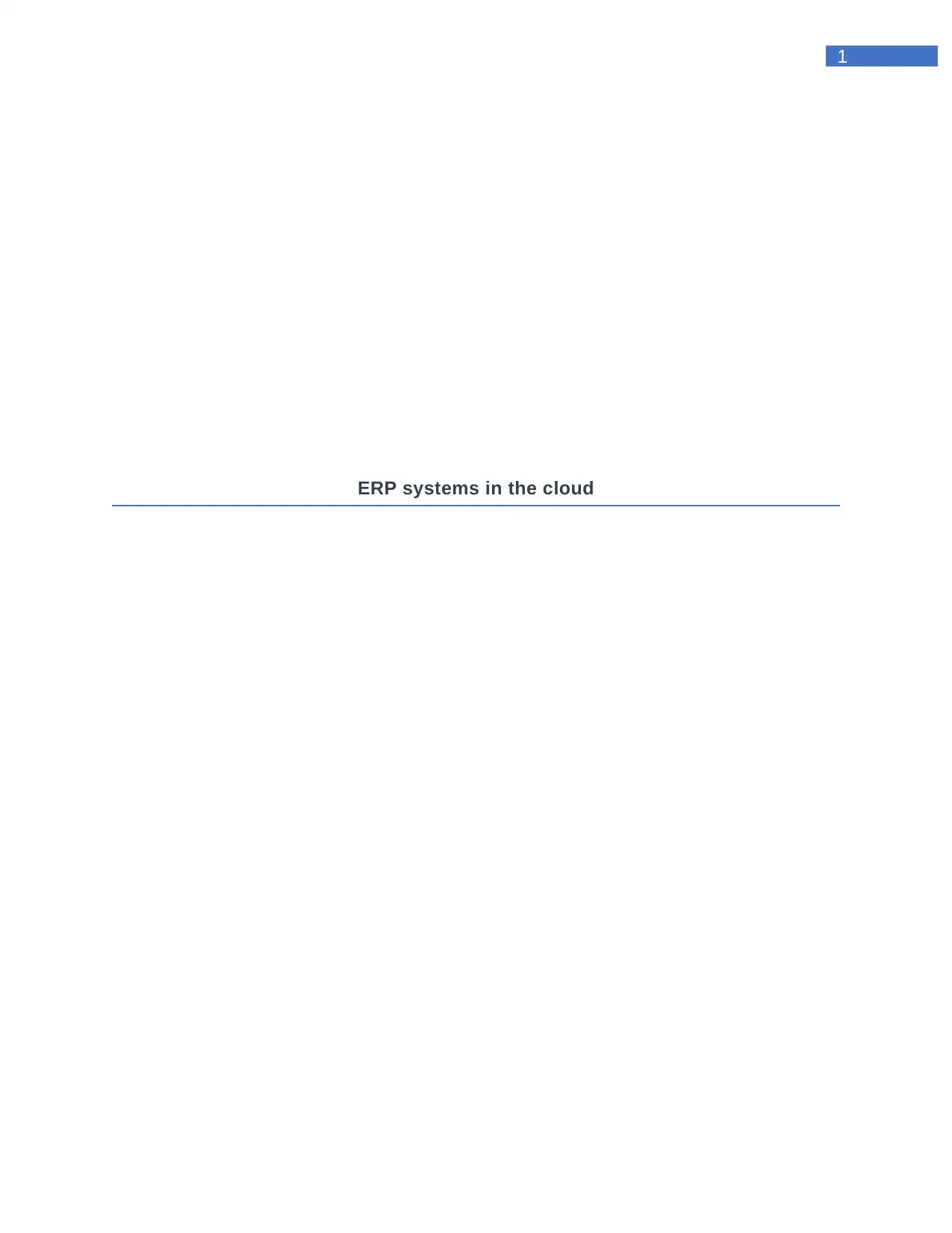
1
ERP systems in the cloud
ERP systems in the cloud
Secure Best Marks with AI Grader
Need help grading? Try our AI Grader for instant feedback on your assignments.
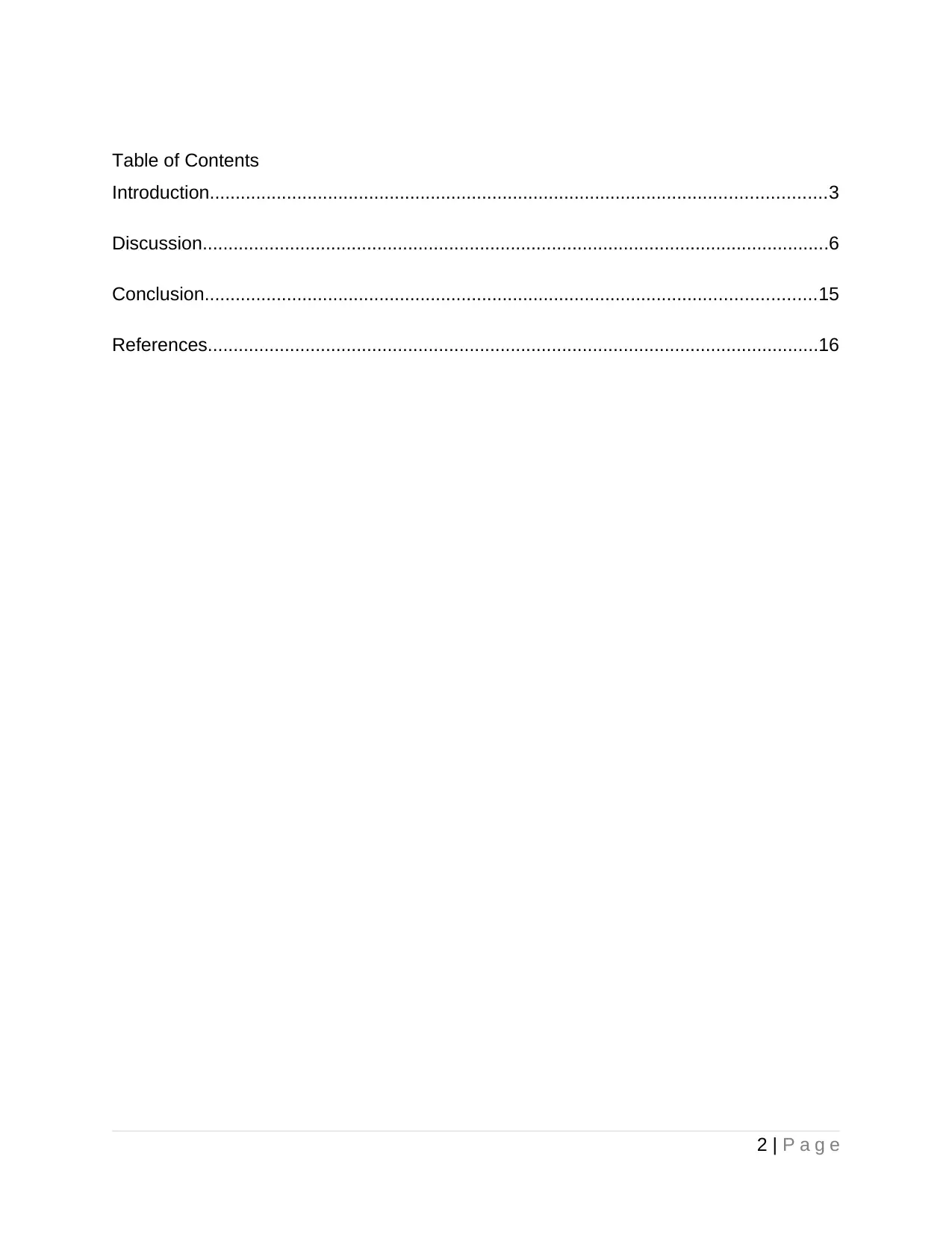
Table of Contents
Introduction........................................................................................................................3
Discussion..........................................................................................................................6
Conclusion.......................................................................................................................15
References.......................................................................................................................16
2 | P a g e
Introduction........................................................................................................................3
Discussion..........................................................................................................................6
Conclusion.......................................................................................................................15
References.......................................................................................................................16
2 | P a g e
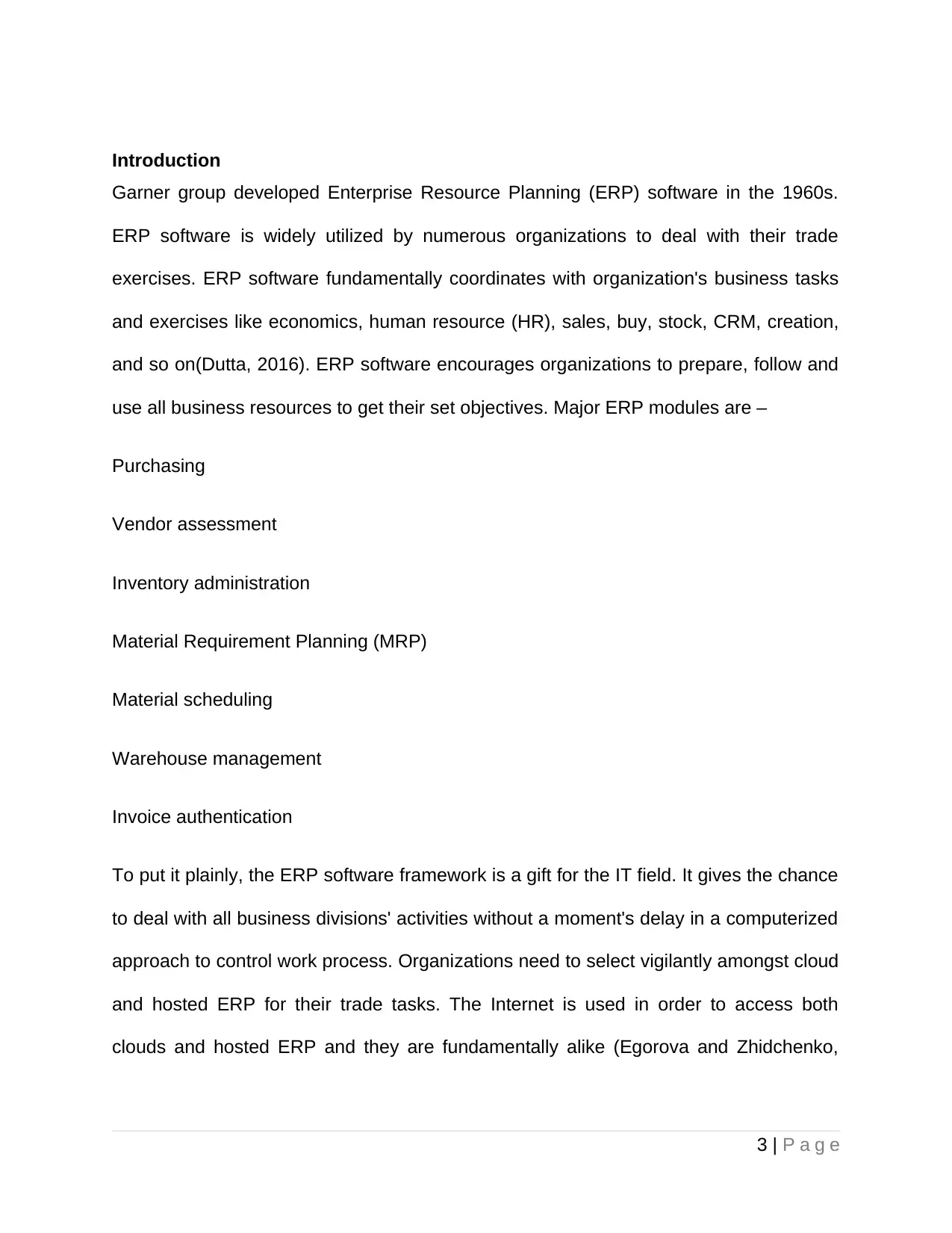
Introduction
Garner group developed Enterprise Resource Planning (ERP) software in the 1960s.
ERP software is widely utilized by numerous organizations to deal with their trade
exercises. ERP software fundamentally coordinates with organization's business tasks
and exercises like economics, human resource (HR), sales, buy, stock, CRM, creation,
and so on(Dutta, 2016). ERP software encourages organizations to prepare, follow and
use all business resources to get their set objectives. Major ERP modules are –
Purchasing
Vendor assessment
Inventory administration
Material Requirement Planning (MRP)
Material scheduling
Warehouse management
Invoice authentication
To put it plainly, the ERP software framework is a gift for the IT field. It gives the chance
to deal with all business divisions' activities without a moment's delay in a computerized
approach to control work process. Organizations need to select vigilantly amongst cloud
and hosted ERP for their trade tasks. The Internet is used in order to access both
clouds and hosted ERP and they are fundamentally alike (Egorova and Zhidchenko,
3 | P a g e
Garner group developed Enterprise Resource Planning (ERP) software in the 1960s.
ERP software is widely utilized by numerous organizations to deal with their trade
exercises. ERP software fundamentally coordinates with organization's business tasks
and exercises like economics, human resource (HR), sales, buy, stock, CRM, creation,
and so on(Dutta, 2016). ERP software encourages organizations to prepare, follow and
use all business resources to get their set objectives. Major ERP modules are –
Purchasing
Vendor assessment
Inventory administration
Material Requirement Planning (MRP)
Material scheduling
Warehouse management
Invoice authentication
To put it plainly, the ERP software framework is a gift for the IT field. It gives the chance
to deal with all business divisions' activities without a moment's delay in a computerized
approach to control work process. Organizations need to select vigilantly amongst cloud
and hosted ERP for their trade tasks. The Internet is used in order to access both
clouds and hosted ERP and they are fundamentally alike (Egorova and Zhidchenko,
3 | P a g e
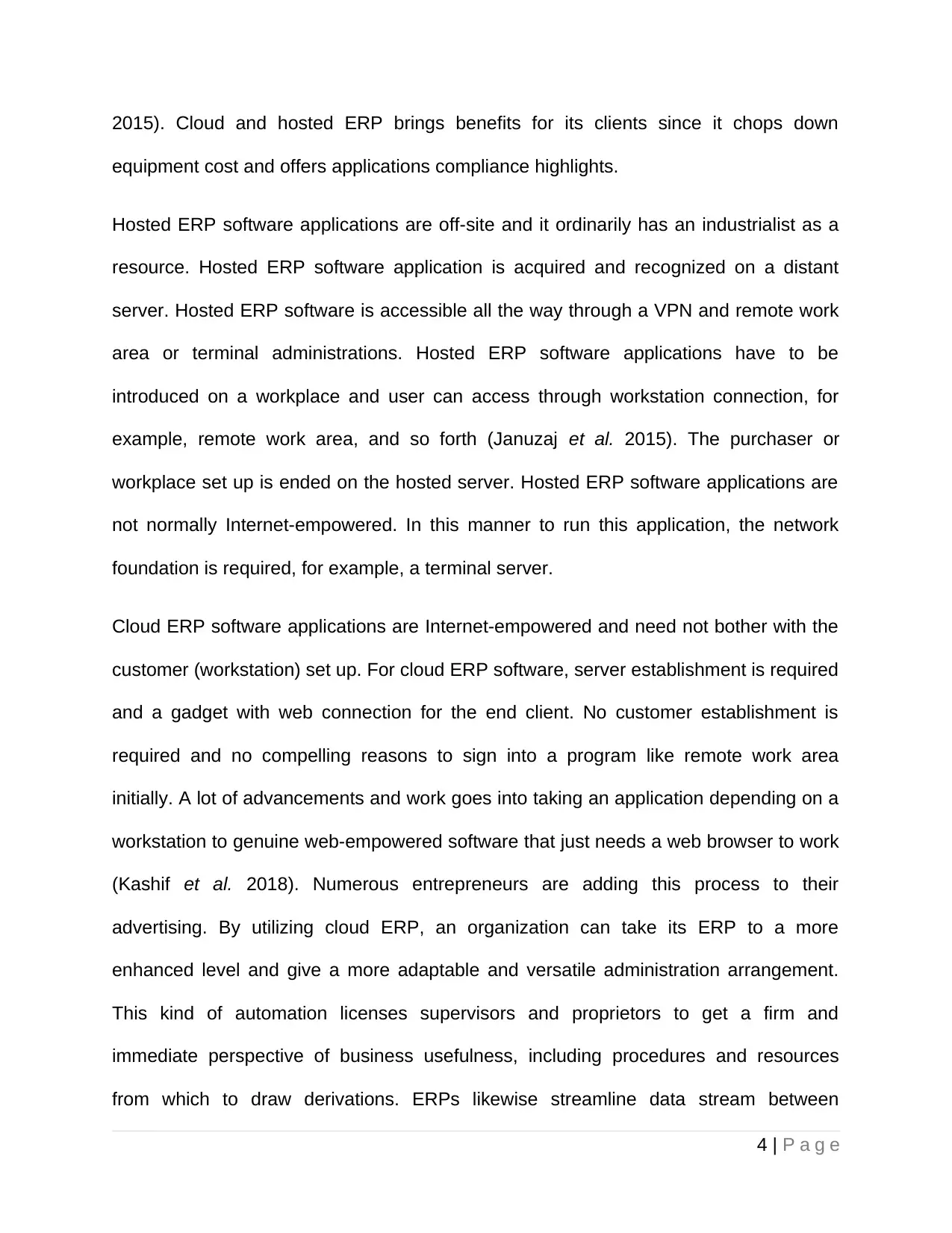
2015). Cloud and hosted ERP brings benefits for its clients since it chops down
equipment cost and offers applications compliance highlights.
Hosted ERP software applications are off-site and it ordinarily has an industrialist as a
resource. Hosted ERP software application is acquired and recognized on a distant
server. Hosted ERP software is accessible all the way through a VPN and remote work
area or terminal administrations. Hosted ERP software applications have to be
introduced on a workplace and user can access through workstation connection, for
example, remote work area, and so forth (Januzaj et al. 2015). The purchaser or
workplace set up is ended on the hosted server. Hosted ERP software applications are
not normally Internet-empowered. In this manner to run this application, the network
foundation is required, for example, a terminal server.
Cloud ERP software applications are Internet-empowered and need not bother with the
customer (workstation) set up. For cloud ERP software, server establishment is required
and a gadget with web connection for the end client. No customer establishment is
required and no compelling reasons to sign into a program like remote work area
initially. A lot of advancements and work goes into taking an application depending on a
workstation to genuine web-empowered software that just needs a web browser to work
(Kashif et al. 2018). Numerous entrepreneurs are adding this process to their
advertising. By utilizing cloud ERP, an organization can take its ERP to a more
enhanced level and give a more adaptable and versatile administration arrangement.
This kind of automation licenses supervisors and proprietors to get a firm and
immediate perspective of business usefulness, including procedures and resources
from which to draw derivations. ERPs likewise streamline data stream between
4 | P a g e
equipment cost and offers applications compliance highlights.
Hosted ERP software applications are off-site and it ordinarily has an industrialist as a
resource. Hosted ERP software application is acquired and recognized on a distant
server. Hosted ERP software is accessible all the way through a VPN and remote work
area or terminal administrations. Hosted ERP software applications have to be
introduced on a workplace and user can access through workstation connection, for
example, remote work area, and so forth (Januzaj et al. 2015). The purchaser or
workplace set up is ended on the hosted server. Hosted ERP software applications are
not normally Internet-empowered. In this manner to run this application, the network
foundation is required, for example, a terminal server.
Cloud ERP software applications are Internet-empowered and need not bother with the
customer (workstation) set up. For cloud ERP software, server establishment is required
and a gadget with web connection for the end client. No customer establishment is
required and no compelling reasons to sign into a program like remote work area
initially. A lot of advancements and work goes into taking an application depending on a
workstation to genuine web-empowered software that just needs a web browser to work
(Kashif et al. 2018). Numerous entrepreneurs are adding this process to their
advertising. By utilizing cloud ERP, an organization can take its ERP to a more
enhanced level and give a more adaptable and versatile administration arrangement.
This kind of automation licenses supervisors and proprietors to get a firm and
immediate perspective of business usefulness, including procedures and resources
from which to draw derivations. ERPs likewise streamline data stream between
4 | P a g e
Secure Best Marks with AI Grader
Need help grading? Try our AI Grader for instant feedback on your assignments.
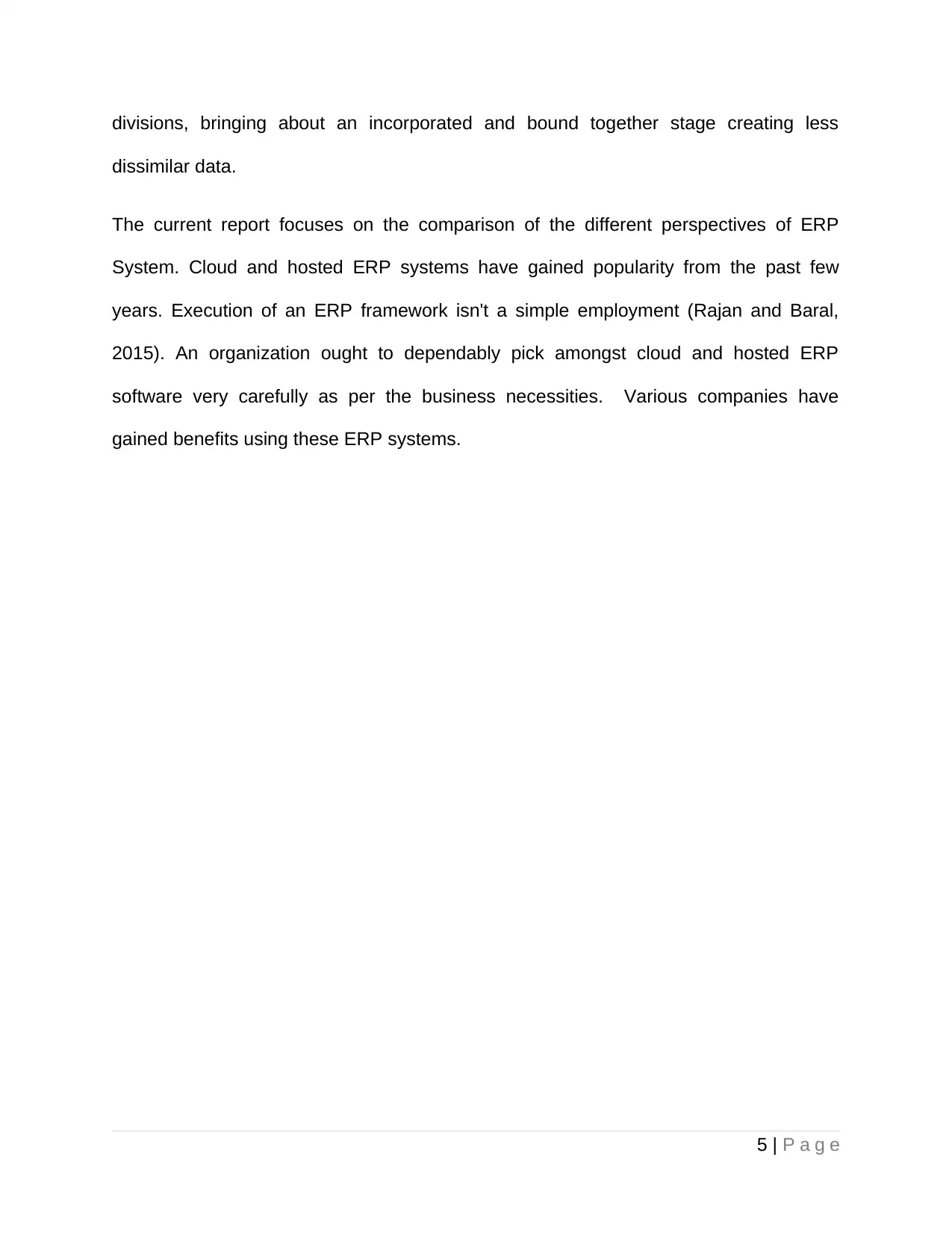
divisions, bringing about an incorporated and bound together stage creating less
dissimilar data.
The current report focuses on the comparison of the different perspectives of ERP
System. Cloud and hosted ERP systems have gained popularity from the past few
years. Execution of an ERP framework isn't a simple employment (Rajan and Baral,
2015). An organization ought to dependably pick amongst cloud and hosted ERP
software very carefully as per the business necessities. Various companies have
gained benefits using these ERP systems.
5 | P a g e
dissimilar data.
The current report focuses on the comparison of the different perspectives of ERP
System. Cloud and hosted ERP systems have gained popularity from the past few
years. Execution of an ERP framework isn't a simple employment (Rajan and Baral,
2015). An organization ought to dependably pick amongst cloud and hosted ERP
software very carefully as per the business necessities. Various companies have
gained benefits using these ERP systems.
5 | P a g e
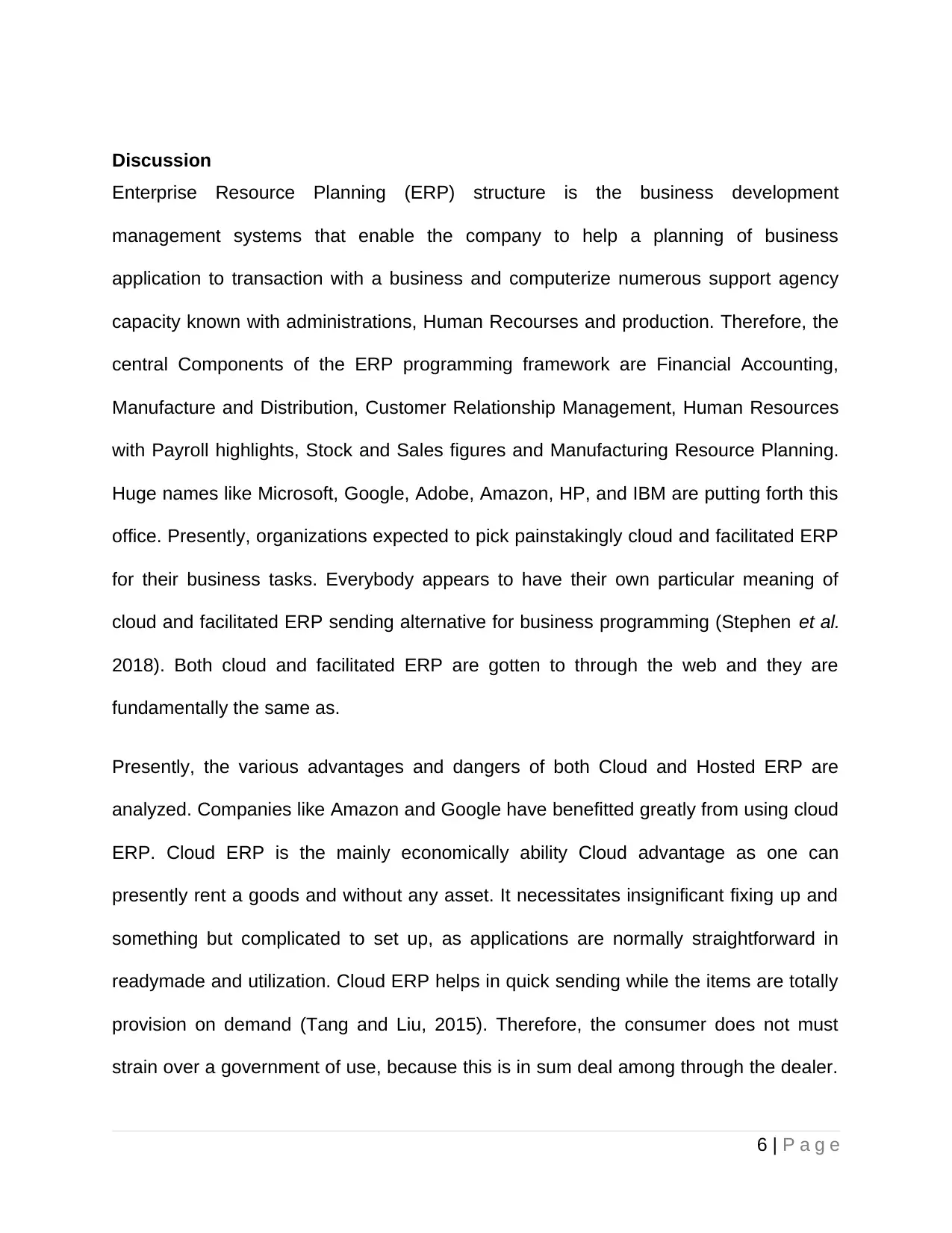
Discussion
Enterprise Resource Planning (ERP) structure is the business development
management systems that enable the company to help a planning of business
application to transaction with a business and computerize numerous support agency
capacity known with administrations, Human Recourses and production. Therefore, the
central Components of the ERP programming framework are Financial Accounting,
Manufacture and Distribution, Customer Relationship Management, Human Resources
with Payroll highlights, Stock and Sales figures and Manufacturing Resource Planning.
Huge names like Microsoft, Google, Adobe, Amazon, HP, and IBM are putting forth this
office. Presently, organizations expected to pick painstakingly cloud and facilitated ERP
for their business tasks. Everybody appears to have their own particular meaning of
cloud and facilitated ERP sending alternative for business programming (Stephen et al.
2018). Both cloud and facilitated ERP are gotten to through the web and they are
fundamentally the same as.
Presently, the various advantages and dangers of both Cloud and Hosted ERP are
analyzed. Companies like Amazon and Google have benefitted greatly from using cloud
ERP. Cloud ERP is the mainly economically ability Cloud advantage as one can
presently rent a goods and without any asset. It necessitates insignificant fixing up and
something but complicated to set up, as applications are normally straightforward in
readymade and utilization. Cloud ERP helps in quick sending while the items are totally
provision on demand (Tang and Liu, 2015). Therefore, the consumer does not must
strain over a government of use, because this is in sum deal among through the dealer.
6 | P a g e
Enterprise Resource Planning (ERP) structure is the business development
management systems that enable the company to help a planning of business
application to transaction with a business and computerize numerous support agency
capacity known with administrations, Human Recourses and production. Therefore, the
central Components of the ERP programming framework are Financial Accounting,
Manufacture and Distribution, Customer Relationship Management, Human Resources
with Payroll highlights, Stock and Sales figures and Manufacturing Resource Planning.
Huge names like Microsoft, Google, Adobe, Amazon, HP, and IBM are putting forth this
office. Presently, organizations expected to pick painstakingly cloud and facilitated ERP
for their business tasks. Everybody appears to have their own particular meaning of
cloud and facilitated ERP sending alternative for business programming (Stephen et al.
2018). Both cloud and facilitated ERP are gotten to through the web and they are
fundamentally the same as.
Presently, the various advantages and dangers of both Cloud and Hosted ERP are
analyzed. Companies like Amazon and Google have benefitted greatly from using cloud
ERP. Cloud ERP is the mainly economically ability Cloud advantage as one can
presently rent a goods and without any asset. It necessitates insignificant fixing up and
something but complicated to set up, as applications are normally straightforward in
readymade and utilization. Cloud ERP helps in quick sending while the items are totally
provision on demand (Tang and Liu, 2015). Therefore, the consumer does not must
strain over a government of use, because this is in sum deal among through the dealer.
6 | P a g e
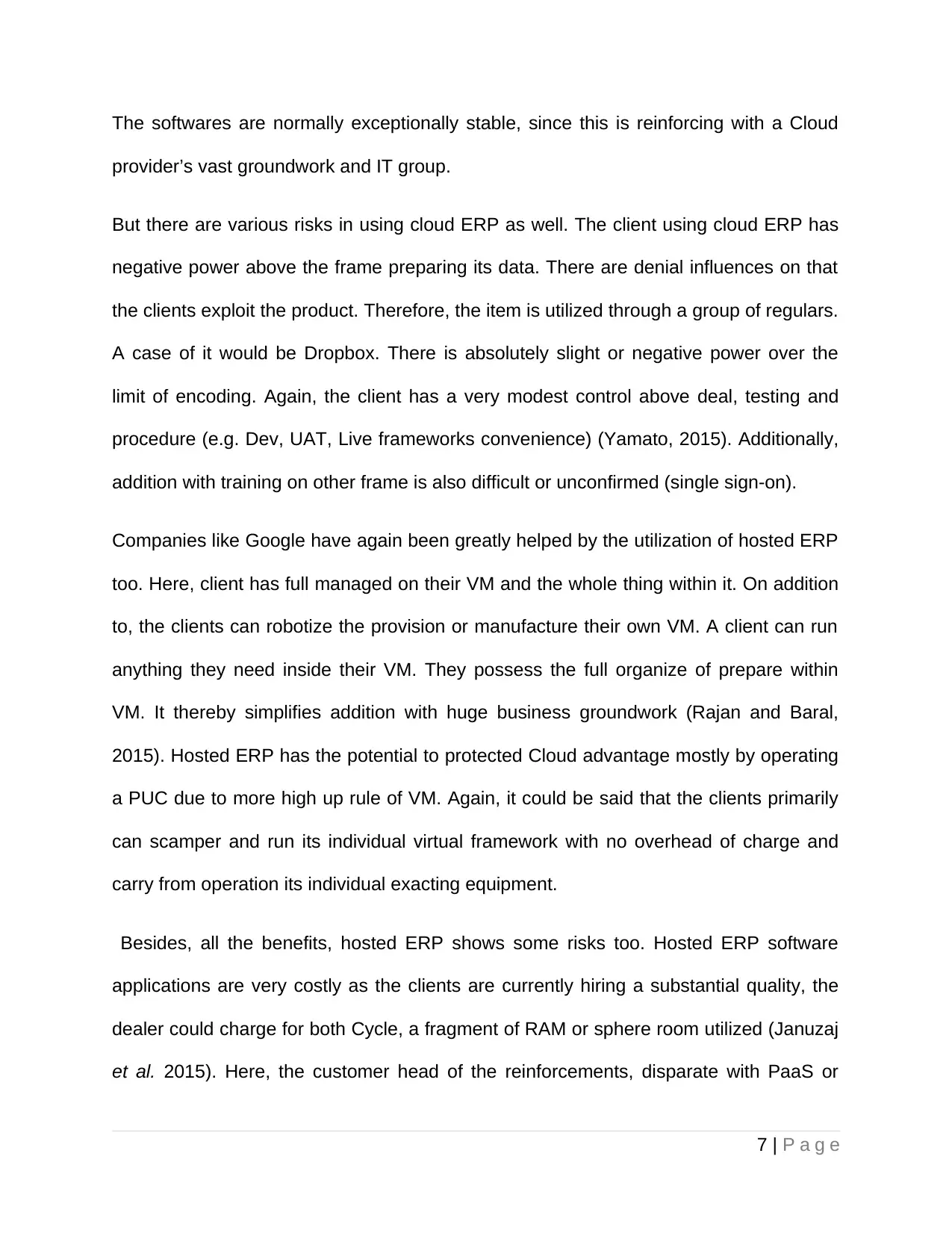
The softwares are normally exceptionally stable, since this is reinforcing with a Cloud
provider’s vast groundwork and IT group.
But there are various risks in using cloud ERP as well. The client using cloud ERP has
negative power above the frame preparing its data. There are denial influences on that
the clients exploit the product. Therefore, the item is utilized through a group of regulars.
A case of it would be Dropbox. There is absolutely slight or negative power over the
limit of encoding. Again, the client has a very modest control above deal, testing and
procedure (e.g. Dev, UAT, Live frameworks convenience) (Yamato, 2015). Additionally,
addition with training on other frame is also difficult or unconfirmed (single sign-on).
Companies like Google have again been greatly helped by the utilization of hosted ERP
too. Here, client has full managed on their VM and the whole thing within it. On addition
to, the clients can robotize the provision or manufacture their own VM. A client can run
anything they need inside their VM. They possess the full organize of prepare within
VM. It thereby simplifies addition with huge business groundwork (Rajan and Baral,
2015). Hosted ERP has the potential to protected Cloud advantage mostly by operating
a PUC due to more high up rule of VM. Again, it could be said that the clients primarily
can scamper and run its individual virtual framework with no overhead of charge and
carry from operation its individual exacting equipment.
Besides, all the benefits, hosted ERP shows some risks too. Hosted ERP software
applications are very costly as the clients are currently hiring a substantial quality, the
dealer could charge for both Cycle, a fragment of RAM or sphere room utilized (Januzaj
et al. 2015). Here, the customer head of the reinforcements, disparate with PaaS or
7 | P a g e
provider’s vast groundwork and IT group.
But there are various risks in using cloud ERP as well. The client using cloud ERP has
negative power above the frame preparing its data. There are denial influences on that
the clients exploit the product. Therefore, the item is utilized through a group of regulars.
A case of it would be Dropbox. There is absolutely slight or negative power over the
limit of encoding. Again, the client has a very modest control above deal, testing and
procedure (e.g. Dev, UAT, Live frameworks convenience) (Yamato, 2015). Additionally,
addition with training on other frame is also difficult or unconfirmed (single sign-on).
Companies like Google have again been greatly helped by the utilization of hosted ERP
too. Here, client has full managed on their VM and the whole thing within it. On addition
to, the clients can robotize the provision or manufacture their own VM. A client can run
anything they need inside their VM. They possess the full organize of prepare within
VM. It thereby simplifies addition with huge business groundwork (Rajan and Baral,
2015). Hosted ERP has the potential to protected Cloud advantage mostly by operating
a PUC due to more high up rule of VM. Again, it could be said that the clients primarily
can scamper and run its individual virtual framework with no overhead of charge and
carry from operation its individual exacting equipment.
Besides, all the benefits, hosted ERP shows some risks too. Hosted ERP software
applications are very costly as the clients are currently hiring a substantial quality, the
dealer could charge for both Cycle, a fragment of RAM or sphere room utilized (Januzaj
et al. 2015). Here, the customer head of the reinforcements, disparate with PaaS or
7 | P a g e
Paraphrase This Document
Need a fresh take? Get an instant paraphrase of this document with our AI Paraphraser
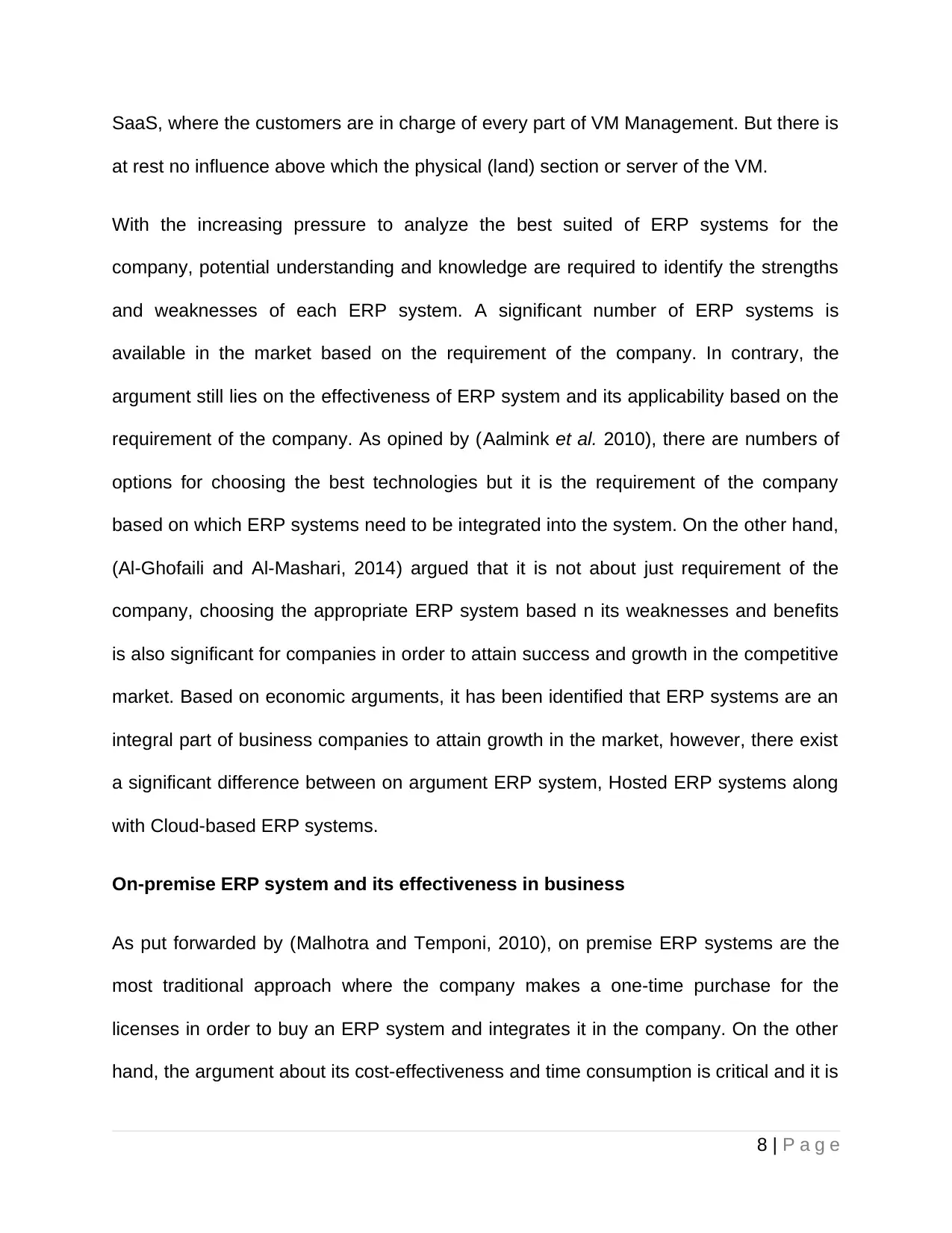
SaaS, where the customers are in charge of every part of VM Management. But there is
at rest no influence above which the physical (land) section or server of the VM.
With the increasing pressure to analyze the best suited of ERP systems for the
company, potential understanding and knowledge are required to identify the strengths
and weaknesses of each ERP system. A significant number of ERP systems is
available in the market based on the requirement of the company. In contrary, the
argument still lies on the effectiveness of ERP system and its applicability based on the
requirement of the company. As opined by (Aalmink et al. 2010), there are numbers of
options for choosing the best technologies but it is the requirement of the company
based on which ERP systems need to be integrated into the system. On the other hand,
(Al-Ghofaili and Al-Mashari, 2014) argued that it is not about just requirement of the
company, choosing the appropriate ERP system based n its weaknesses and benefits
is also significant for companies in order to attain success and growth in the competitive
market. Based on economic arguments, it has been identified that ERP systems are an
integral part of business companies to attain growth in the market, however, there exist
a significant difference between on argument ERP system, Hosted ERP systems along
with Cloud-based ERP systems.
On-premise ERP system and its effectiveness in business
As put forwarded by (Malhotra and Temponi, 2010), on premise ERP systems are the
most traditional approach where the company makes a one-time purchase for the
licenses in order to buy an ERP system and integrates it in the company. On the other
hand, the argument about its cost-effectiveness and time consumption is critical and it is
8 | P a g e
at rest no influence above which the physical (land) section or server of the VM.
With the increasing pressure to analyze the best suited of ERP systems for the
company, potential understanding and knowledge are required to identify the strengths
and weaknesses of each ERP system. A significant number of ERP systems is
available in the market based on the requirement of the company. In contrary, the
argument still lies on the effectiveness of ERP system and its applicability based on the
requirement of the company. As opined by (Aalmink et al. 2010), there are numbers of
options for choosing the best technologies but it is the requirement of the company
based on which ERP systems need to be integrated into the system. On the other hand,
(Al-Ghofaili and Al-Mashari, 2014) argued that it is not about just requirement of the
company, choosing the appropriate ERP system based n its weaknesses and benefits
is also significant for companies in order to attain success and growth in the competitive
market. Based on economic arguments, it has been identified that ERP systems are an
integral part of business companies to attain growth in the market, however, there exist
a significant difference between on argument ERP system, Hosted ERP systems along
with Cloud-based ERP systems.
On-premise ERP system and its effectiveness in business
As put forwarded by (Malhotra and Temponi, 2010), on premise ERP systems are the
most traditional approach where the company makes a one-time purchase for the
licenses in order to buy an ERP system and integrates it in the company. On the other
hand, the argument about its cost-effectiveness and time consumption is critical and it is
8 | P a g e
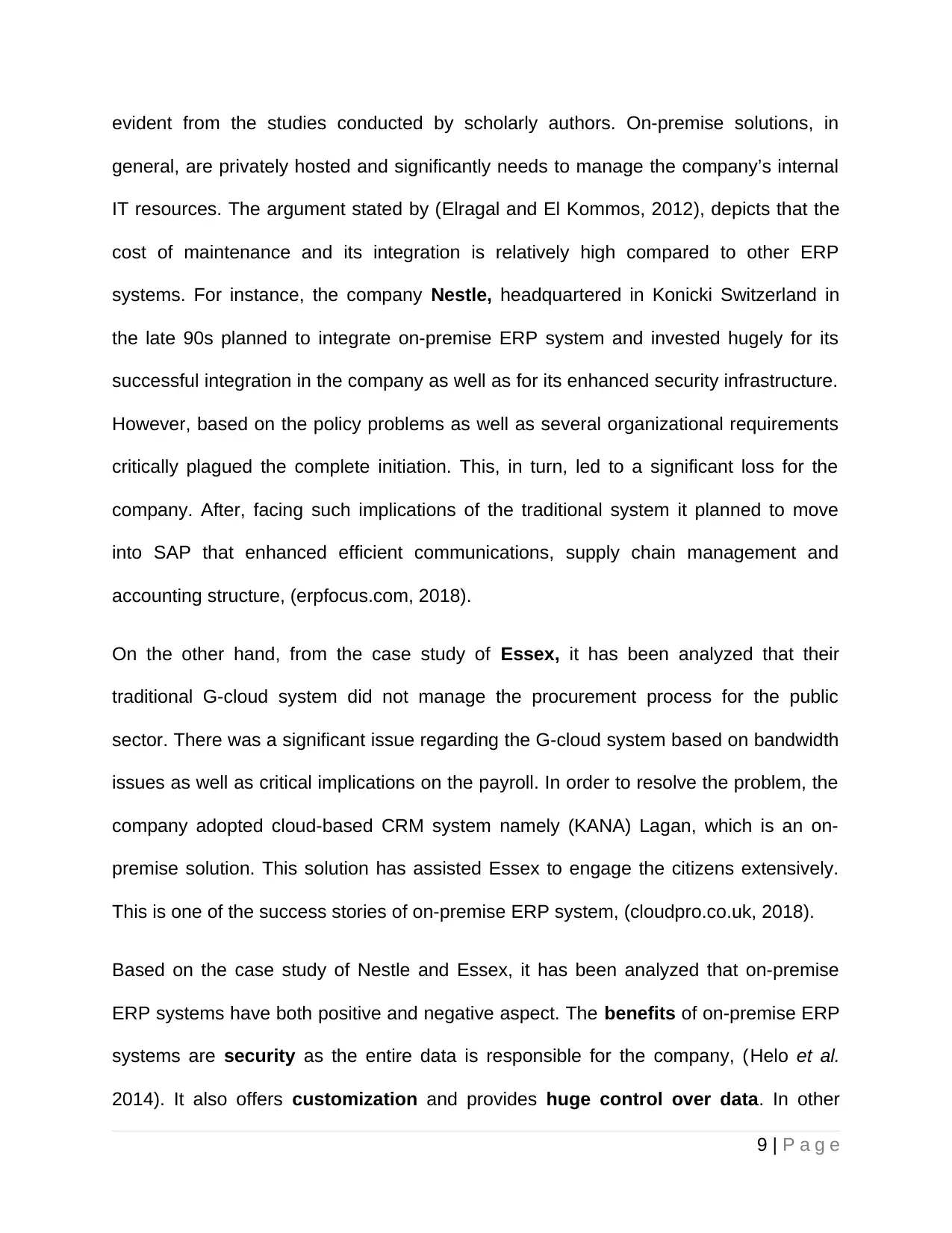
evident from the studies conducted by scholarly authors. On-premise solutions, in
general, are privately hosted and significantly needs to manage the company’s internal
IT resources. The argument stated by (Elragal and El Kommos, 2012), depicts that the
cost of maintenance and its integration is relatively high compared to other ERP
systems. For instance, the company Nestle, headquartered in Konicki Switzerland in
the late 90s planned to integrate on-premise ERP system and invested hugely for its
successful integration in the company as well as for its enhanced security infrastructure.
However, based on the policy problems as well as several organizational requirements
critically plagued the complete initiation. This, in turn, led to a significant loss for the
company. After, facing such implications of the traditional system it planned to move
into SAP that enhanced efficient communications, supply chain management and
accounting structure, (erpfocus.com, 2018).
On the other hand, from the case study of Essex, it has been analyzed that their
traditional G-cloud system did not manage the procurement process for the public
sector. There was a significant issue regarding the G-cloud system based on bandwidth
issues as well as critical implications on the payroll. In order to resolve the problem, the
company adopted cloud-based CRM system namely (KANA) Lagan, which is an on-
premise solution. This solution has assisted Essex to engage the citizens extensively.
This is one of the success stories of on-premise ERP system, (cloudpro.co.uk, 2018).
Based on the case study of Nestle and Essex, it has been analyzed that on-premise
ERP systems have both positive and negative aspect. The benefits of on-premise ERP
systems are security as the entire data is responsible for the company, (Helo et al.
2014). It also offers customization and provides huge control over data. In other
9 | P a g e
general, are privately hosted and significantly needs to manage the company’s internal
IT resources. The argument stated by (Elragal and El Kommos, 2012), depicts that the
cost of maintenance and its integration is relatively high compared to other ERP
systems. For instance, the company Nestle, headquartered in Konicki Switzerland in
the late 90s planned to integrate on-premise ERP system and invested hugely for its
successful integration in the company as well as for its enhanced security infrastructure.
However, based on the policy problems as well as several organizational requirements
critically plagued the complete initiation. This, in turn, led to a significant loss for the
company. After, facing such implications of the traditional system it planned to move
into SAP that enhanced efficient communications, supply chain management and
accounting structure, (erpfocus.com, 2018).
On the other hand, from the case study of Essex, it has been analyzed that their
traditional G-cloud system did not manage the procurement process for the public
sector. There was a significant issue regarding the G-cloud system based on bandwidth
issues as well as critical implications on the payroll. In order to resolve the problem, the
company adopted cloud-based CRM system namely (KANA) Lagan, which is an on-
premise solution. This solution has assisted Essex to engage the citizens extensively.
This is one of the success stories of on-premise ERP system, (cloudpro.co.uk, 2018).
Based on the case study of Nestle and Essex, it has been analyzed that on-premise
ERP systems have both positive and negative aspect. The benefits of on-premise ERP
systems are security as the entire data is responsible for the company, (Helo et al.
2014). It also offers customization and provides huge control over data. In other
9 | P a g e
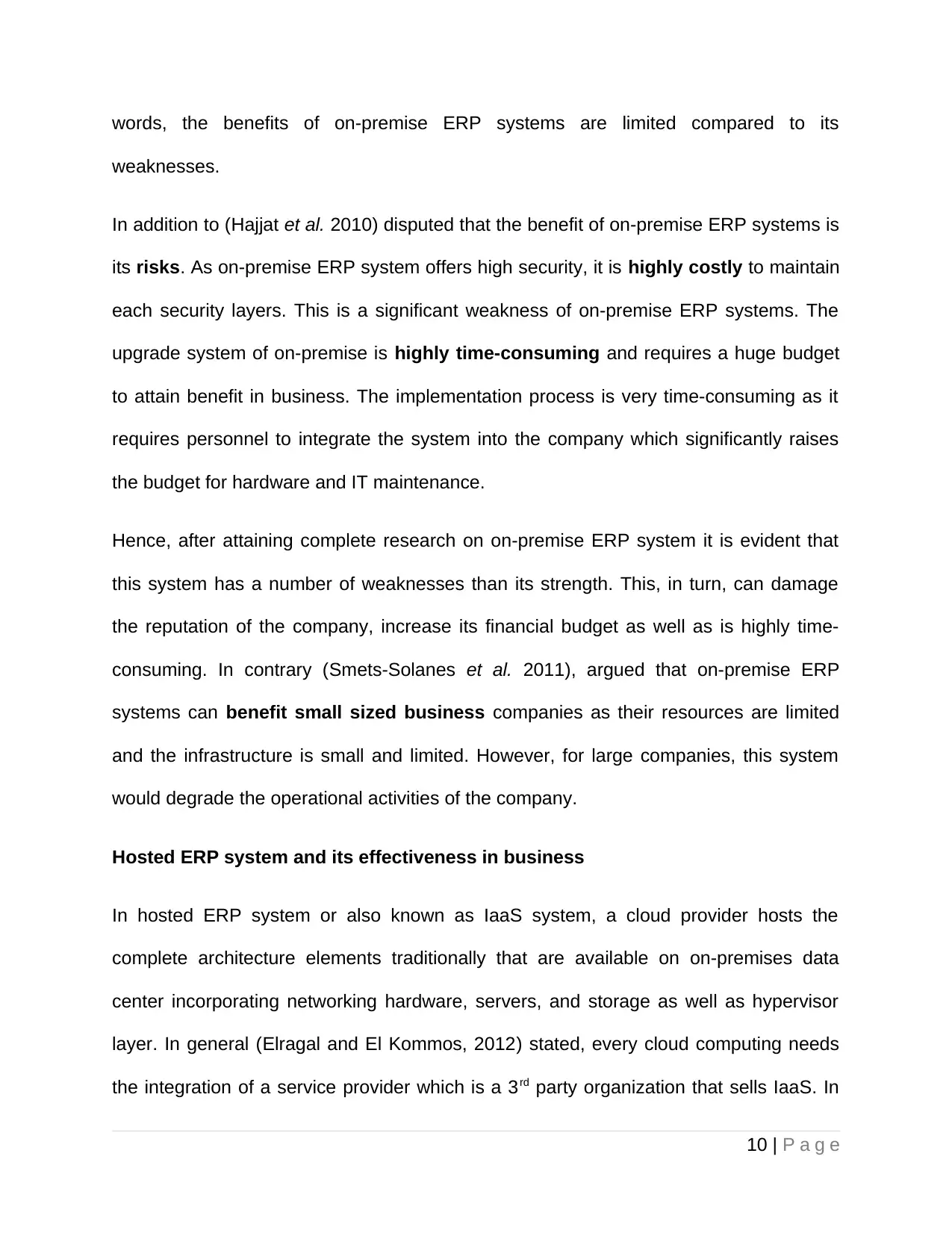
words, the benefits of on-premise ERP systems are limited compared to its
weaknesses.
In addition to (Hajjat et al. 2010) disputed that the benefit of on-premise ERP systems is
its risks. As on-premise ERP system offers high security, it is highly costly to maintain
each security layers. This is a significant weakness of on-premise ERP systems. The
upgrade system of on-premise is highly time-consuming and requires a huge budget
to attain benefit in business. The implementation process is very time-consuming as it
requires personnel to integrate the system into the company which significantly raises
the budget for hardware and IT maintenance.
Hence, after attaining complete research on on-premise ERP system it is evident that
this system has a number of weaknesses than its strength. This, in turn, can damage
the reputation of the company, increase its financial budget as well as is highly time-
consuming. In contrary (Smets-Solanes et al. 2011), argued that on-premise ERP
systems can benefit small sized business companies as their resources are limited
and the infrastructure is small and limited. However, for large companies, this system
would degrade the operational activities of the company.
Hosted ERP system and its effectiveness in business
In hosted ERP system or also known as IaaS system, a cloud provider hosts the
complete architecture elements traditionally that are available on on-premises data
center incorporating networking hardware, servers, and storage as well as hypervisor
layer. In general (Elragal and El Kommos, 2012) stated, every cloud computing needs
the integration of a service provider which is a 3rd party organization that sells IaaS. In
10 | P a g e
weaknesses.
In addition to (Hajjat et al. 2010) disputed that the benefit of on-premise ERP systems is
its risks. As on-premise ERP system offers high security, it is highly costly to maintain
each security layers. This is a significant weakness of on-premise ERP systems. The
upgrade system of on-premise is highly time-consuming and requires a huge budget
to attain benefit in business. The implementation process is very time-consuming as it
requires personnel to integrate the system into the company which significantly raises
the budget for hardware and IT maintenance.
Hence, after attaining complete research on on-premise ERP system it is evident that
this system has a number of weaknesses than its strength. This, in turn, can damage
the reputation of the company, increase its financial budget as well as is highly time-
consuming. In contrary (Smets-Solanes et al. 2011), argued that on-premise ERP
systems can benefit small sized business companies as their resources are limited
and the infrastructure is small and limited. However, for large companies, this system
would degrade the operational activities of the company.
Hosted ERP system and its effectiveness in business
In hosted ERP system or also known as IaaS system, a cloud provider hosts the
complete architecture elements traditionally that are available on on-premises data
center incorporating networking hardware, servers, and storage as well as hypervisor
layer. In general (Elragal and El Kommos, 2012) stated, every cloud computing needs
the integration of a service provider which is a 3rd party organization that sells IaaS. In
10 | P a g e
Secure Best Marks with AI Grader
Need help grading? Try our AI Grader for instant feedback on your assignments.
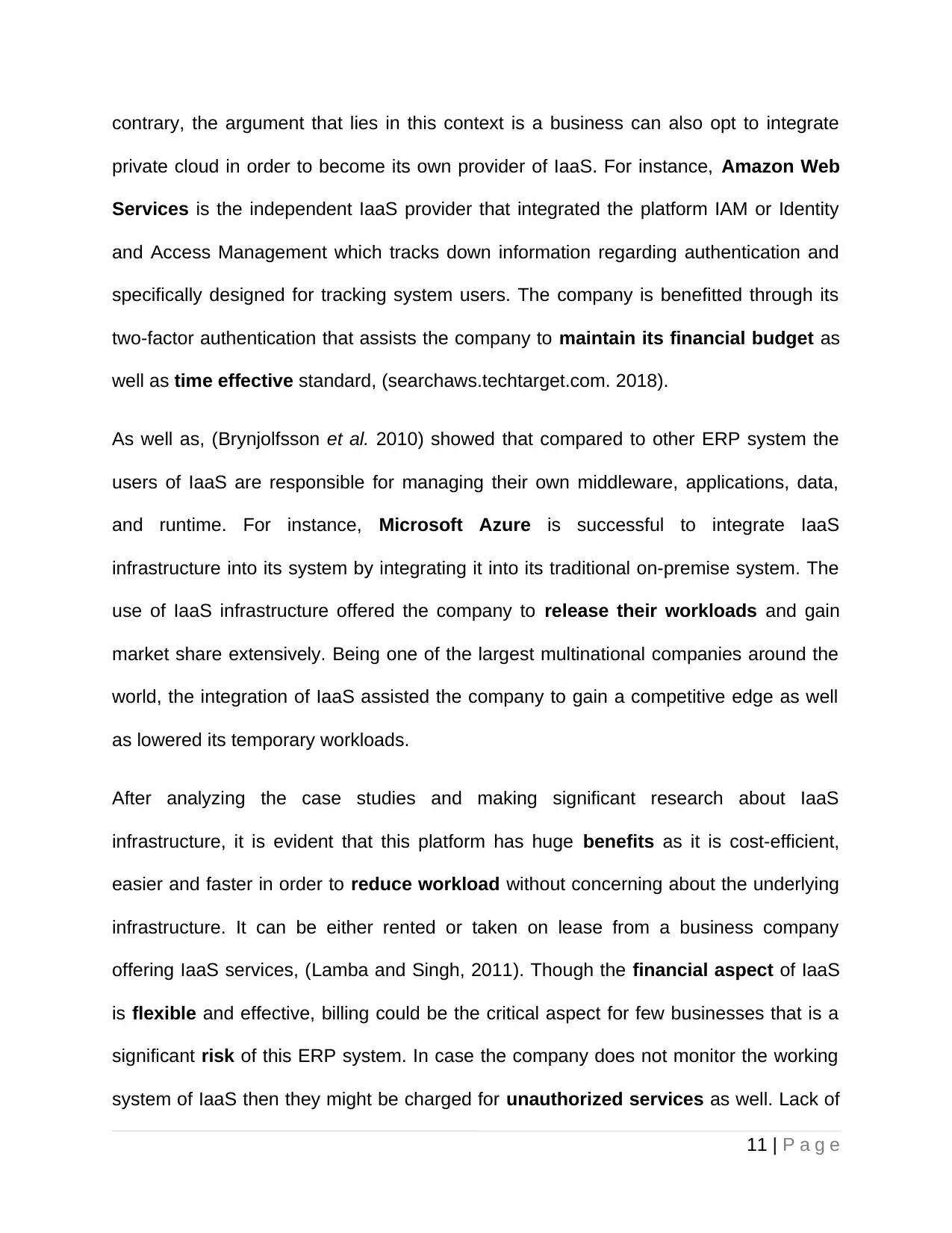
contrary, the argument that lies in this context is a business can also opt to integrate
private cloud in order to become its own provider of IaaS. For instance, Amazon Web
Services is the independent IaaS provider that integrated the platform IAM or Identity
and Access Management which tracks down information regarding authentication and
specifically designed for tracking system users. The company is benefitted through its
two-factor authentication that assists the company to maintain its financial budget as
well as time effective standard, (searchaws.techtarget.com. 2018).
As well as, (Brynjolfsson et al. 2010) showed that compared to other ERP system the
users of IaaS are responsible for managing their own middleware, applications, data,
and runtime. For instance, Microsoft Azure is successful to integrate IaaS
infrastructure into its system by integrating it into its traditional on-premise system. The
use of IaaS infrastructure offered the company to release their workloads and gain
market share extensively. Being one of the largest multinational companies around the
world, the integration of IaaS assisted the company to gain a competitive edge as well
as lowered its temporary workloads.
After analyzing the case studies and making significant research about IaaS
infrastructure, it is evident that this platform has huge benefits as it is cost-efficient,
easier and faster in order to reduce workload without concerning about the underlying
infrastructure. It can be either rented or taken on lease from a business company
offering IaaS services, (Lamba and Singh, 2011). Though the financial aspect of IaaS
is flexible and effective, billing could be the critical aspect for few businesses that is a
significant risk of this ERP system. In case the company does not monitor the working
system of IaaS then they might be charged for unauthorized services as well. Lack of
11 | P a g e
private cloud in order to become its own provider of IaaS. For instance, Amazon Web
Services is the independent IaaS provider that integrated the platform IAM or Identity
and Access Management which tracks down information regarding authentication and
specifically designed for tracking system users. The company is benefitted through its
two-factor authentication that assists the company to maintain its financial budget as
well as time effective standard, (searchaws.techtarget.com. 2018).
As well as, (Brynjolfsson et al. 2010) showed that compared to other ERP system the
users of IaaS are responsible for managing their own middleware, applications, data,
and runtime. For instance, Microsoft Azure is successful to integrate IaaS
infrastructure into its system by integrating it into its traditional on-premise system. The
use of IaaS infrastructure offered the company to release their workloads and gain
market share extensively. Being one of the largest multinational companies around the
world, the integration of IaaS assisted the company to gain a competitive edge as well
as lowered its temporary workloads.
After analyzing the case studies and making significant research about IaaS
infrastructure, it is evident that this platform has huge benefits as it is cost-efficient,
easier and faster in order to reduce workload without concerning about the underlying
infrastructure. It can be either rented or taken on lease from a business company
offering IaaS services, (Lamba and Singh, 2011). Though the financial aspect of IaaS
is flexible and effective, billing could be the critical aspect for few businesses that is a
significant risk of this ERP system. In case the company does not monitor the working
system of IaaS then they might be charged for unauthorized services as well. Lack of
11 | P a g e
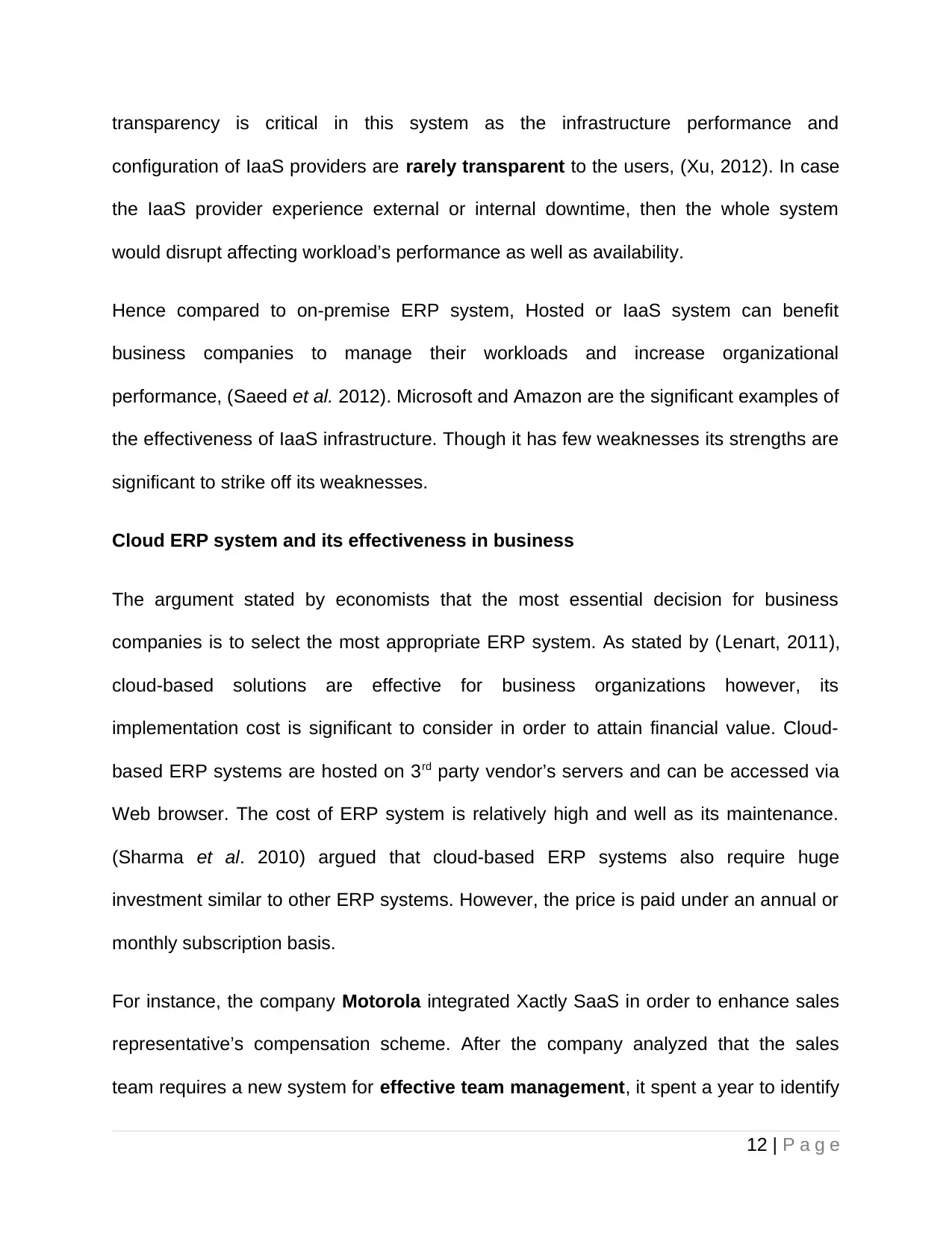
transparency is critical in this system as the infrastructure performance and
configuration of IaaS providers are rarely transparent to the users, (Xu, 2012). In case
the IaaS provider experience external or internal downtime, then the whole system
would disrupt affecting workload’s performance as well as availability.
Hence compared to on-premise ERP system, Hosted or IaaS system can benefit
business companies to manage their workloads and increase organizational
performance, (Saeed et al. 2012). Microsoft and Amazon are the significant examples of
the effectiveness of IaaS infrastructure. Though it has few weaknesses its strengths are
significant to strike off its weaknesses.
Cloud ERP system and its effectiveness in business
The argument stated by economists that the most essential decision for business
companies is to select the most appropriate ERP system. As stated by (Lenart, 2011),
cloud-based solutions are effective for business organizations however, its
implementation cost is significant to consider in order to attain financial value. Cloud-
based ERP systems are hosted on 3rd party vendor’s servers and can be accessed via
Web browser. The cost of ERP system is relatively high and well as its maintenance.
(Sharma et al. 2010) argued that cloud-based ERP systems also require huge
investment similar to other ERP systems. However, the price is paid under an annual or
monthly subscription basis.
For instance, the company Motorola integrated Xactly SaaS in order to enhance sales
representative’s compensation scheme. After the company analyzed that the sales
team requires a new system for effective team management, it spent a year to identify
12 | P a g e
configuration of IaaS providers are rarely transparent to the users, (Xu, 2012). In case
the IaaS provider experience external or internal downtime, then the whole system
would disrupt affecting workload’s performance as well as availability.
Hence compared to on-premise ERP system, Hosted or IaaS system can benefit
business companies to manage their workloads and increase organizational
performance, (Saeed et al. 2012). Microsoft and Amazon are the significant examples of
the effectiveness of IaaS infrastructure. Though it has few weaknesses its strengths are
significant to strike off its weaknesses.
Cloud ERP system and its effectiveness in business
The argument stated by economists that the most essential decision for business
companies is to select the most appropriate ERP system. As stated by (Lenart, 2011),
cloud-based solutions are effective for business organizations however, its
implementation cost is significant to consider in order to attain financial value. Cloud-
based ERP systems are hosted on 3rd party vendor’s servers and can be accessed via
Web browser. The cost of ERP system is relatively high and well as its maintenance.
(Sharma et al. 2010) argued that cloud-based ERP systems also require huge
investment similar to other ERP systems. However, the price is paid under an annual or
monthly subscription basis.
For instance, the company Motorola integrated Xactly SaaS in order to enhance sales
representative’s compensation scheme. After the company analyzed that the sales
team requires a new system for effective team management, it spent a year to identify
12 | P a g e
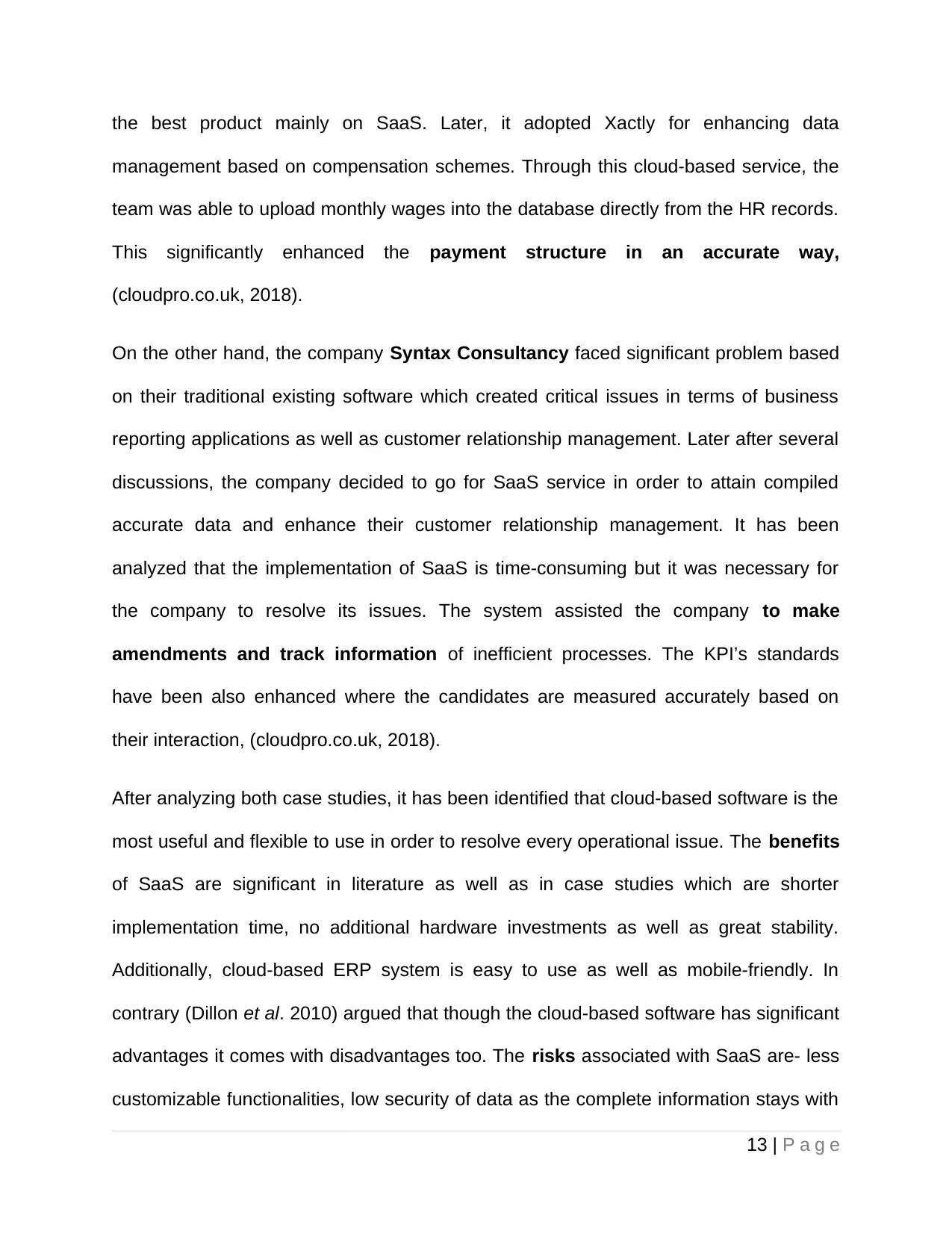
the best product mainly on SaaS. Later, it adopted Xactly for enhancing data
management based on compensation schemes. Through this cloud-based service, the
team was able to upload monthly wages into the database directly from the HR records.
This significantly enhanced the payment structure in an accurate way,
(cloudpro.co.uk, 2018).
On the other hand, the company Syntax Consultancy faced significant problem based
on their traditional existing software which created critical issues in terms of business
reporting applications as well as customer relationship management. Later after several
discussions, the company decided to go for SaaS service in order to attain compiled
accurate data and enhance their customer relationship management. It has been
analyzed that the implementation of SaaS is time-consuming but it was necessary for
the company to resolve its issues. The system assisted the company to make
amendments and track information of inefficient processes. The KPI’s standards
have been also enhanced where the candidates are measured accurately based on
their interaction, (cloudpro.co.uk, 2018).
After analyzing both case studies, it has been identified that cloud-based software is the
most useful and flexible to use in order to resolve every operational issue. The benefits
of SaaS are significant in literature as well as in case studies which are shorter
implementation time, no additional hardware investments as well as great stability.
Additionally, cloud-based ERP system is easy to use as well as mobile-friendly. In
contrary (Dillon et al. 2010) argued that though the cloud-based software has significant
advantages it comes with disadvantages too. The risks associated with SaaS are- less
customizable functionalities, low security of data as the complete information stays with
13 | P a g e
management based on compensation schemes. Through this cloud-based service, the
team was able to upload monthly wages into the database directly from the HR records.
This significantly enhanced the payment structure in an accurate way,
(cloudpro.co.uk, 2018).
On the other hand, the company Syntax Consultancy faced significant problem based
on their traditional existing software which created critical issues in terms of business
reporting applications as well as customer relationship management. Later after several
discussions, the company decided to go for SaaS service in order to attain compiled
accurate data and enhance their customer relationship management. It has been
analyzed that the implementation of SaaS is time-consuming but it was necessary for
the company to resolve its issues. The system assisted the company to make
amendments and track information of inefficient processes. The KPI’s standards
have been also enhanced where the candidates are measured accurately based on
their interaction, (cloudpro.co.uk, 2018).
After analyzing both case studies, it has been identified that cloud-based software is the
most useful and flexible to use in order to resolve every operational issue. The benefits
of SaaS are significant in literature as well as in case studies which are shorter
implementation time, no additional hardware investments as well as great stability.
Additionally, cloud-based ERP system is easy to use as well as mobile-friendly. In
contrary (Dillon et al. 2010) argued that though the cloud-based software has significant
advantages it comes with disadvantages too. The risks associated with SaaS are- less
customizable functionalities, low security of data as the complete information stays with
13 | P a g e
Paraphrase This Document
Need a fresh take? Get an instant paraphrase of this document with our AI Paraphraser
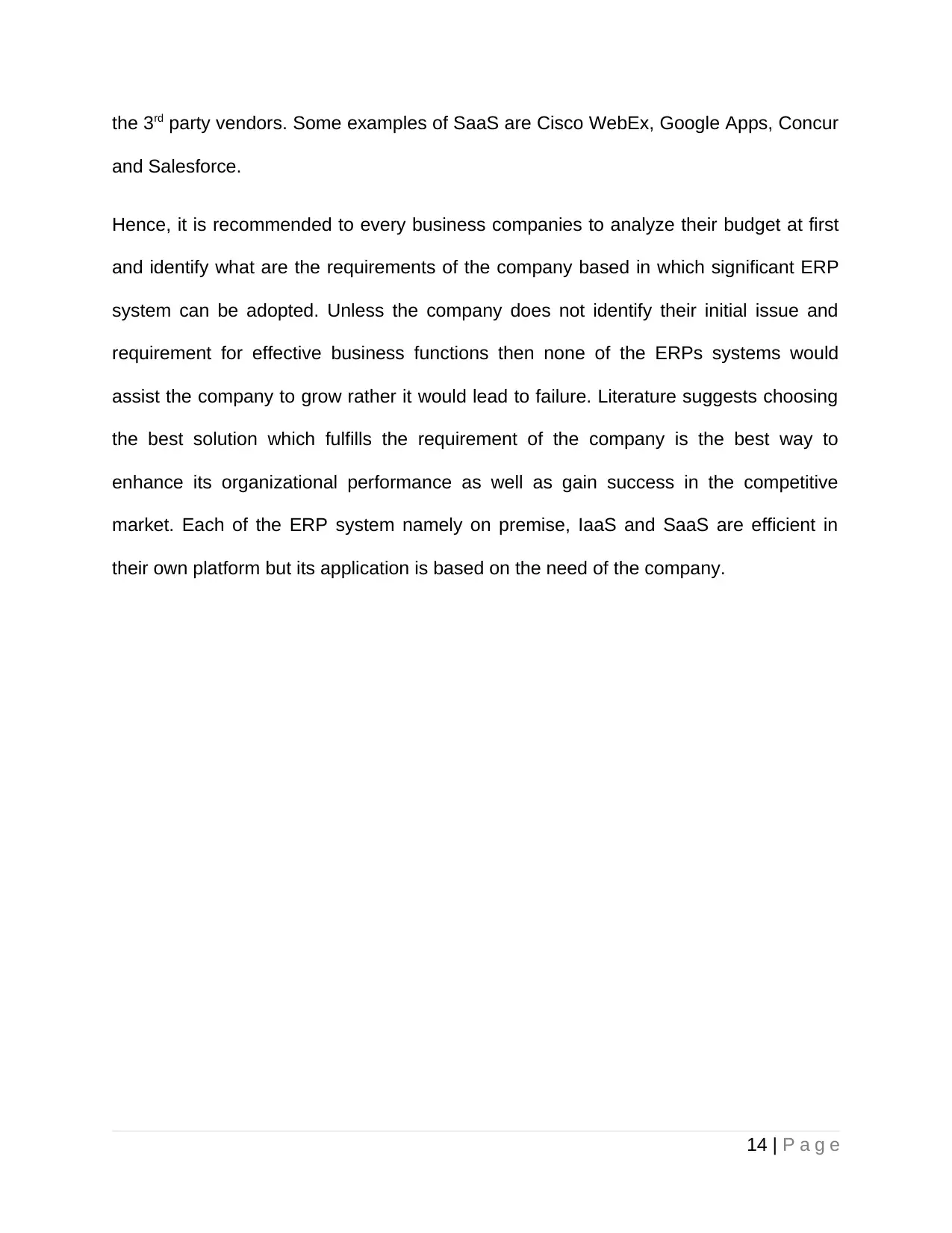
the 3rd party vendors. Some examples of SaaS are Cisco WebEx, Google Apps, Concur
and Salesforce.
Hence, it is recommended to every business companies to analyze their budget at first
and identify what are the requirements of the company based in which significant ERP
system can be adopted. Unless the company does not identify their initial issue and
requirement for effective business functions then none of the ERPs systems would
assist the company to grow rather it would lead to failure. Literature suggests choosing
the best solution which fulfills the requirement of the company is the best way to
enhance its organizational performance as well as gain success in the competitive
market. Each of the ERP system namely on premise, IaaS and SaaS are efficient in
their own platform but its application is based on the need of the company.
14 | P a g e
and Salesforce.
Hence, it is recommended to every business companies to analyze their budget at first
and identify what are the requirements of the company based in which significant ERP
system can be adopted. Unless the company does not identify their initial issue and
requirement for effective business functions then none of the ERPs systems would
assist the company to grow rather it would lead to failure. Literature suggests choosing
the best solution which fulfills the requirement of the company is the best way to
enhance its organizational performance as well as gain success in the competitive
market. Each of the ERP system namely on premise, IaaS and SaaS are efficient in
their own platform but its application is based on the need of the company.
14 | P a g e
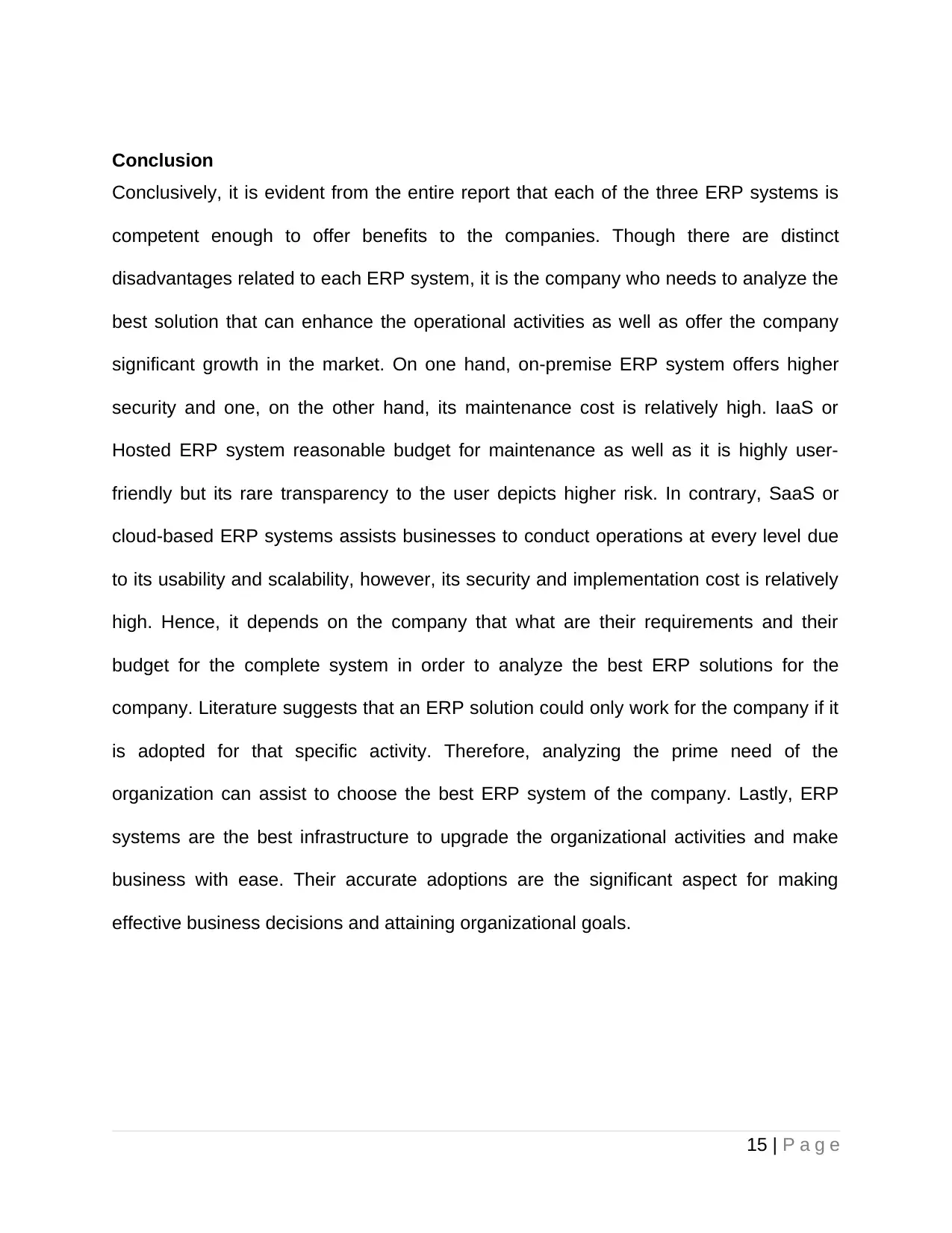
Conclusion
Conclusively, it is evident from the entire report that each of the three ERP systems is
competent enough to offer benefits to the companies. Though there are distinct
disadvantages related to each ERP system, it is the company who needs to analyze the
best solution that can enhance the operational activities as well as offer the company
significant growth in the market. On one hand, on-premise ERP system offers higher
security and one, on the other hand, its maintenance cost is relatively high. IaaS or
Hosted ERP system reasonable budget for maintenance as well as it is highly user-
friendly but its rare transparency to the user depicts higher risk. In contrary, SaaS or
cloud-based ERP systems assists businesses to conduct operations at every level due
to its usability and scalability, however, its security and implementation cost is relatively
high. Hence, it depends on the company that what are their requirements and their
budget for the complete system in order to analyze the best ERP solutions for the
company. Literature suggests that an ERP solution could only work for the company if it
is adopted for that specific activity. Therefore, analyzing the prime need of the
organization can assist to choose the best ERP system of the company. Lastly, ERP
systems are the best infrastructure to upgrade the organizational activities and make
business with ease. Their accurate adoptions are the significant aspect for making
effective business decisions and attaining organizational goals.
15 | P a g e
Conclusively, it is evident from the entire report that each of the three ERP systems is
competent enough to offer benefits to the companies. Though there are distinct
disadvantages related to each ERP system, it is the company who needs to analyze the
best solution that can enhance the operational activities as well as offer the company
significant growth in the market. On one hand, on-premise ERP system offers higher
security and one, on the other hand, its maintenance cost is relatively high. IaaS or
Hosted ERP system reasonable budget for maintenance as well as it is highly user-
friendly but its rare transparency to the user depicts higher risk. In contrary, SaaS or
cloud-based ERP systems assists businesses to conduct operations at every level due
to its usability and scalability, however, its security and implementation cost is relatively
high. Hence, it depends on the company that what are their requirements and their
budget for the complete system in order to analyze the best ERP solutions for the
company. Literature suggests that an ERP solution could only work for the company if it
is adopted for that specific activity. Therefore, analyzing the prime need of the
organization can assist to choose the best ERP system of the company. Lastly, ERP
systems are the best infrastructure to upgrade the organizational activities and make
business with ease. Their accurate adoptions are the significant aspect for making
effective business decisions and attaining organizational goals.
15 | P a g e
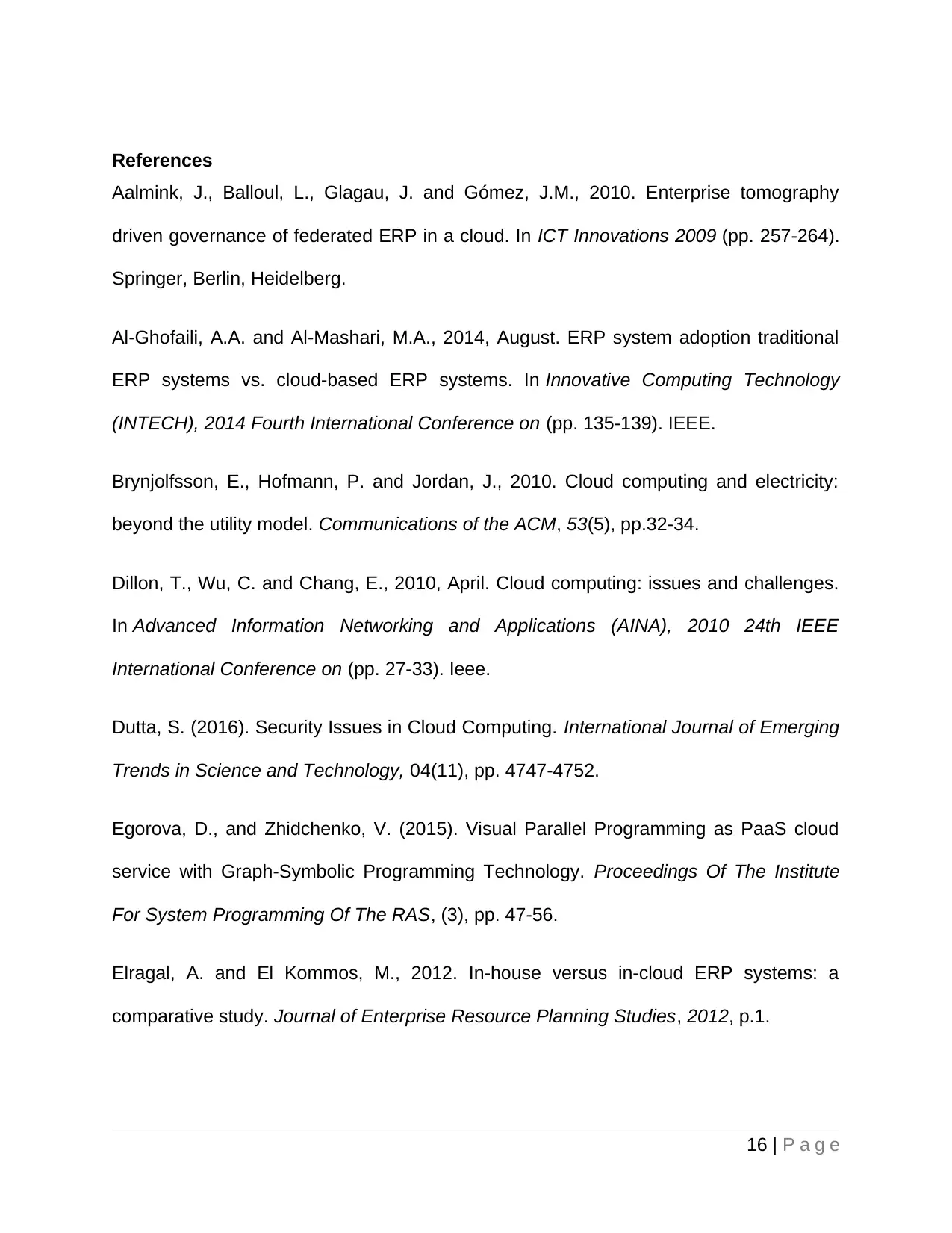
References
Aalmink, J., Balloul, L., Glagau, J. and Gómez, J.M., 2010. Enterprise tomography
driven governance of federated ERP in a cloud. In ICT Innovations 2009 (pp. 257-264).
Springer, Berlin, Heidelberg.
Al-Ghofaili, A.A. and Al-Mashari, M.A., 2014, August. ERP system adoption traditional
ERP systems vs. cloud-based ERP systems. In Innovative Computing Technology
(INTECH), 2014 Fourth International Conference on (pp. 135-139). IEEE.
Brynjolfsson, E., Hofmann, P. and Jordan, J., 2010. Cloud computing and electricity:
beyond the utility model. Communications of the ACM, 53(5), pp.32-34.
Dillon, T., Wu, C. and Chang, E., 2010, April. Cloud computing: issues and challenges.
In Advanced Information Networking and Applications (AINA), 2010 24th IEEE
International Conference on (pp. 27-33). Ieee.
Dutta, S. (2016). Security Issues in Cloud Computing. International Journal of Emerging
Trends in Science and Technology, 04(11), pp. 4747-4752.
Egorova, D., and Zhidchenko, V. (2015). Visual Parallel Programming as PaaS cloud
service with Graph-Symbolic Programming Technology. Proceedings Of The Institute
For System Programming Of The RAS, (3), pp. 47-56.
Elragal, A. and El Kommos, M., 2012. In-house versus in-cloud ERP systems: a
comparative study. Journal of Enterprise Resource Planning Studies, 2012, p.1.
16 | P a g e
Aalmink, J., Balloul, L., Glagau, J. and Gómez, J.M., 2010. Enterprise tomography
driven governance of federated ERP in a cloud. In ICT Innovations 2009 (pp. 257-264).
Springer, Berlin, Heidelberg.
Al-Ghofaili, A.A. and Al-Mashari, M.A., 2014, August. ERP system adoption traditional
ERP systems vs. cloud-based ERP systems. In Innovative Computing Technology
(INTECH), 2014 Fourth International Conference on (pp. 135-139). IEEE.
Brynjolfsson, E., Hofmann, P. and Jordan, J., 2010. Cloud computing and electricity:
beyond the utility model. Communications of the ACM, 53(5), pp.32-34.
Dillon, T., Wu, C. and Chang, E., 2010, April. Cloud computing: issues and challenges.
In Advanced Information Networking and Applications (AINA), 2010 24th IEEE
International Conference on (pp. 27-33). Ieee.
Dutta, S. (2016). Security Issues in Cloud Computing. International Journal of Emerging
Trends in Science and Technology, 04(11), pp. 4747-4752.
Egorova, D., and Zhidchenko, V. (2015). Visual Parallel Programming as PaaS cloud
service with Graph-Symbolic Programming Technology. Proceedings Of The Institute
For System Programming Of The RAS, (3), pp. 47-56.
Elragal, A. and El Kommos, M., 2012. In-house versus in-cloud ERP systems: a
comparative study. Journal of Enterprise Resource Planning Studies, 2012, p.1.
16 | P a g e
Secure Best Marks with AI Grader
Need help grading? Try our AI Grader for instant feedback on your assignments.
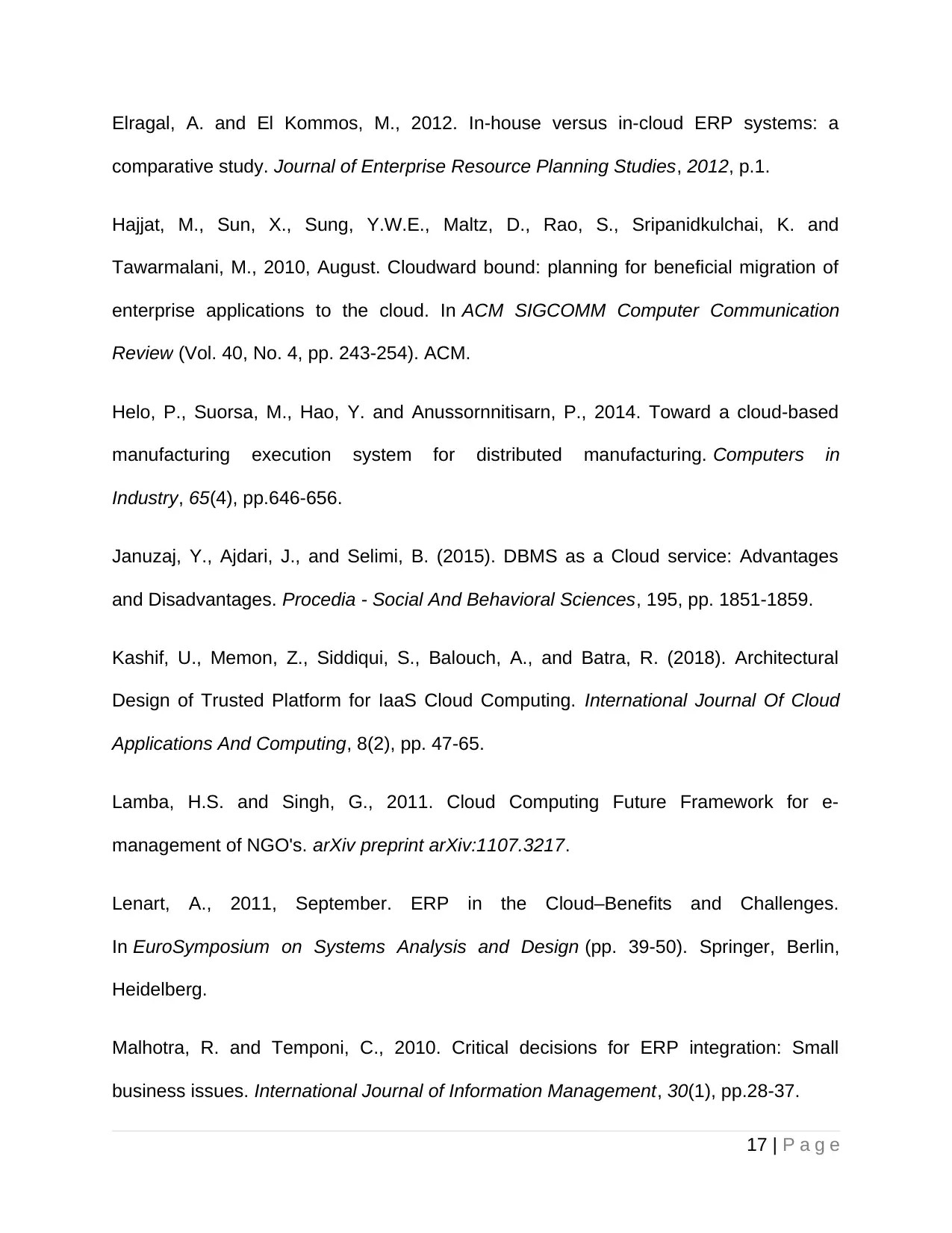
Elragal, A. and El Kommos, M., 2012. In-house versus in-cloud ERP systems: a
comparative study. Journal of Enterprise Resource Planning Studies, 2012, p.1.
Hajjat, M., Sun, X., Sung, Y.W.E., Maltz, D., Rao, S., Sripanidkulchai, K. and
Tawarmalani, M., 2010, August. Cloudward bound: planning for beneficial migration of
enterprise applications to the cloud. In ACM SIGCOMM Computer Communication
Review (Vol. 40, No. 4, pp. 243-254). ACM.
Helo, P., Suorsa, M., Hao, Y. and Anussornnitisarn, P., 2014. Toward a cloud-based
manufacturing execution system for distributed manufacturing. Computers in
Industry, 65(4), pp.646-656.
Januzaj, Y., Ajdari, J., and Selimi, B. (2015). DBMS as a Cloud service: Advantages
and Disadvantages. Procedia - Social And Behavioral Sciences, 195, pp. 1851-1859.
Kashif, U., Memon, Z., Siddiqui, S., Balouch, A., and Batra, R. (2018). Architectural
Design of Trusted Platform for IaaS Cloud Computing. International Journal Of Cloud
Applications And Computing, 8(2), pp. 47-65.
Lamba, H.S. and Singh, G., 2011. Cloud Computing Future Framework for e-
management of NGO's. arXiv preprint arXiv:1107.3217.
Lenart, A., 2011, September. ERP in the Cloud–Benefits and Challenges.
In EuroSymposium on Systems Analysis and Design (pp. 39-50). Springer, Berlin,
Heidelberg.
Malhotra, R. and Temponi, C., 2010. Critical decisions for ERP integration: Small
business issues. International Journal of Information Management, 30(1), pp.28-37.
17 | P a g e
comparative study. Journal of Enterprise Resource Planning Studies, 2012, p.1.
Hajjat, M., Sun, X., Sung, Y.W.E., Maltz, D., Rao, S., Sripanidkulchai, K. and
Tawarmalani, M., 2010, August. Cloudward bound: planning for beneficial migration of
enterprise applications to the cloud. In ACM SIGCOMM Computer Communication
Review (Vol. 40, No. 4, pp. 243-254). ACM.
Helo, P., Suorsa, M., Hao, Y. and Anussornnitisarn, P., 2014. Toward a cloud-based
manufacturing execution system for distributed manufacturing. Computers in
Industry, 65(4), pp.646-656.
Januzaj, Y., Ajdari, J., and Selimi, B. (2015). DBMS as a Cloud service: Advantages
and Disadvantages. Procedia - Social And Behavioral Sciences, 195, pp. 1851-1859.
Kashif, U., Memon, Z., Siddiqui, S., Balouch, A., and Batra, R. (2018). Architectural
Design of Trusted Platform for IaaS Cloud Computing. International Journal Of Cloud
Applications And Computing, 8(2), pp. 47-65.
Lamba, H.S. and Singh, G., 2011. Cloud Computing Future Framework for e-
management of NGO's. arXiv preprint arXiv:1107.3217.
Lenart, A., 2011, September. ERP in the Cloud–Benefits and Challenges.
In EuroSymposium on Systems Analysis and Design (pp. 39-50). Springer, Berlin,
Heidelberg.
Malhotra, R. and Temponi, C., 2010. Critical decisions for ERP integration: Small
business issues. International Journal of Information Management, 30(1), pp.28-37.
17 | P a g e
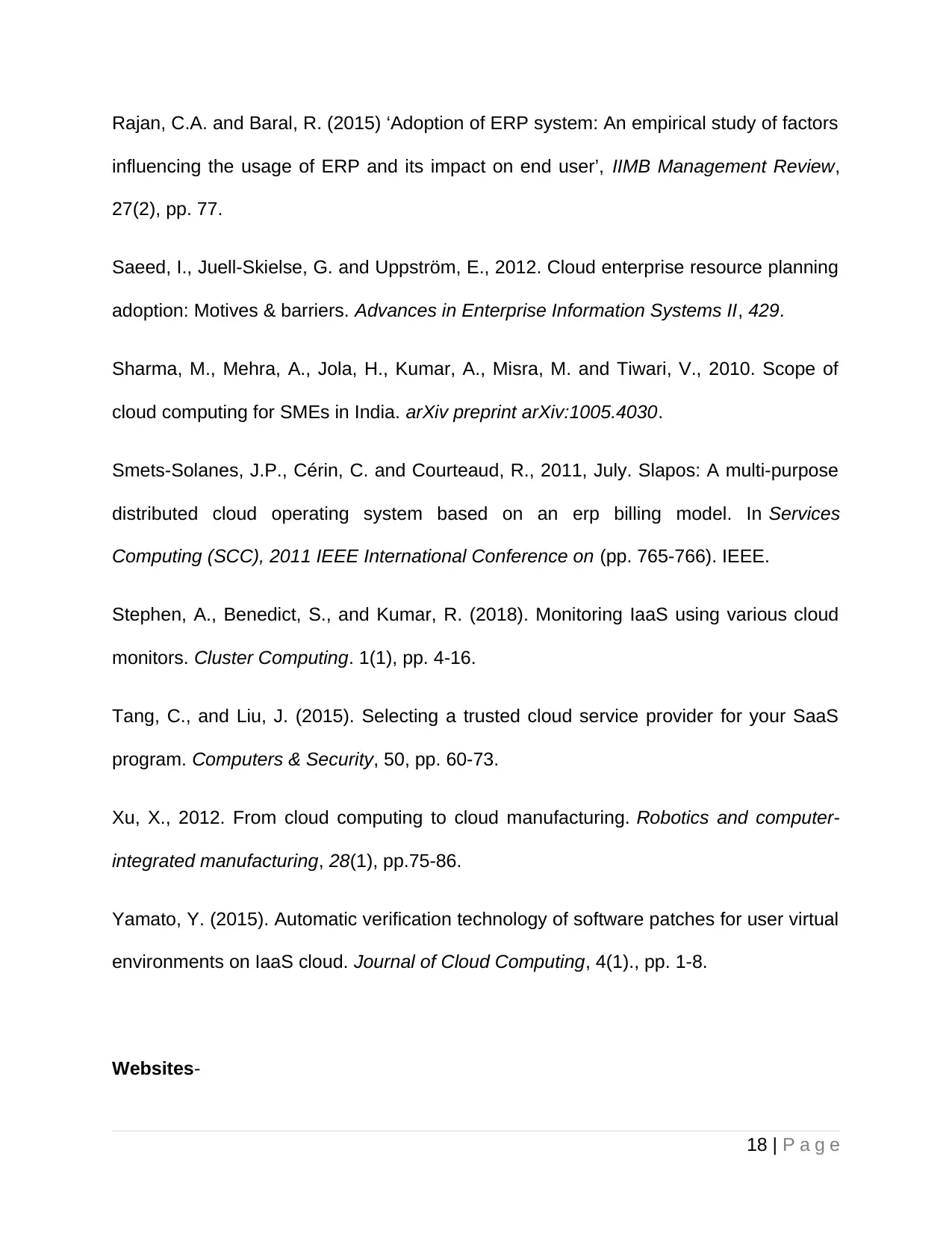
Rajan, C.A. and Baral, R. (2015) ‘Adoption of ERP system: An empirical study of factors
influencing the usage of ERP and its impact on end user’, IIMB Management Review,
27(2), pp. 77.
Saeed, I., Juell-Skielse, G. and Uppström, E., 2012. Cloud enterprise resource planning
adoption: Motives & barriers. Advances in Enterprise Information Systems II, 429.
Sharma, M., Mehra, A., Jola, H., Kumar, A., Misra, M. and Tiwari, V., 2010. Scope of
cloud computing for SMEs in India. arXiv preprint arXiv:1005.4030.
Smets-Solanes, J.P., Cérin, C. and Courteaud, R., 2011, July. Slapos: A multi-purpose
distributed cloud operating system based on an erp billing model. In Services
Computing (SCC), 2011 IEEE International Conference on (pp. 765-766). IEEE.
Stephen, A., Benedict, S., and Kumar, R. (2018). Monitoring IaaS using various cloud
monitors. Cluster Computing. 1(1), pp. 4-16.
Tang, C., and Liu, J. (2015). Selecting a trusted cloud service provider for your SaaS
program. Computers & Security, 50, pp. 60-73.
Xu, X., 2012. From cloud computing to cloud manufacturing. Robotics and computer-
integrated manufacturing, 28(1), pp.75-86.
Yamato, Y. (2015). Automatic verification technology of software patches for user virtual
environments on IaaS cloud. Journal of Cloud Computing, 4(1)., pp. 1-8.
Websites-
18 | P a g e
influencing the usage of ERP and its impact on end user’, IIMB Management Review,
27(2), pp. 77.
Saeed, I., Juell-Skielse, G. and Uppström, E., 2012. Cloud enterprise resource planning
adoption: Motives & barriers. Advances in Enterprise Information Systems II, 429.
Sharma, M., Mehra, A., Jola, H., Kumar, A., Misra, M. and Tiwari, V., 2010. Scope of
cloud computing for SMEs in India. arXiv preprint arXiv:1005.4030.
Smets-Solanes, J.P., Cérin, C. and Courteaud, R., 2011, July. Slapos: A multi-purpose
distributed cloud operating system based on an erp billing model. In Services
Computing (SCC), 2011 IEEE International Conference on (pp. 765-766). IEEE.
Stephen, A., Benedict, S., and Kumar, R. (2018). Monitoring IaaS using various cloud
monitors. Cluster Computing. 1(1), pp. 4-16.
Tang, C., and Liu, J. (2015). Selecting a trusted cloud service provider for your SaaS
program. Computers & Security, 50, pp. 60-73.
Xu, X., 2012. From cloud computing to cloud manufacturing. Robotics and computer-
integrated manufacturing, 28(1), pp.75-86.
Yamato, Y. (2015). Automatic verification technology of software patches for user virtual
environments on IaaS cloud. Journal of Cloud Computing, 4(1)., pp. 1-8.
Websites-
18 | P a g e
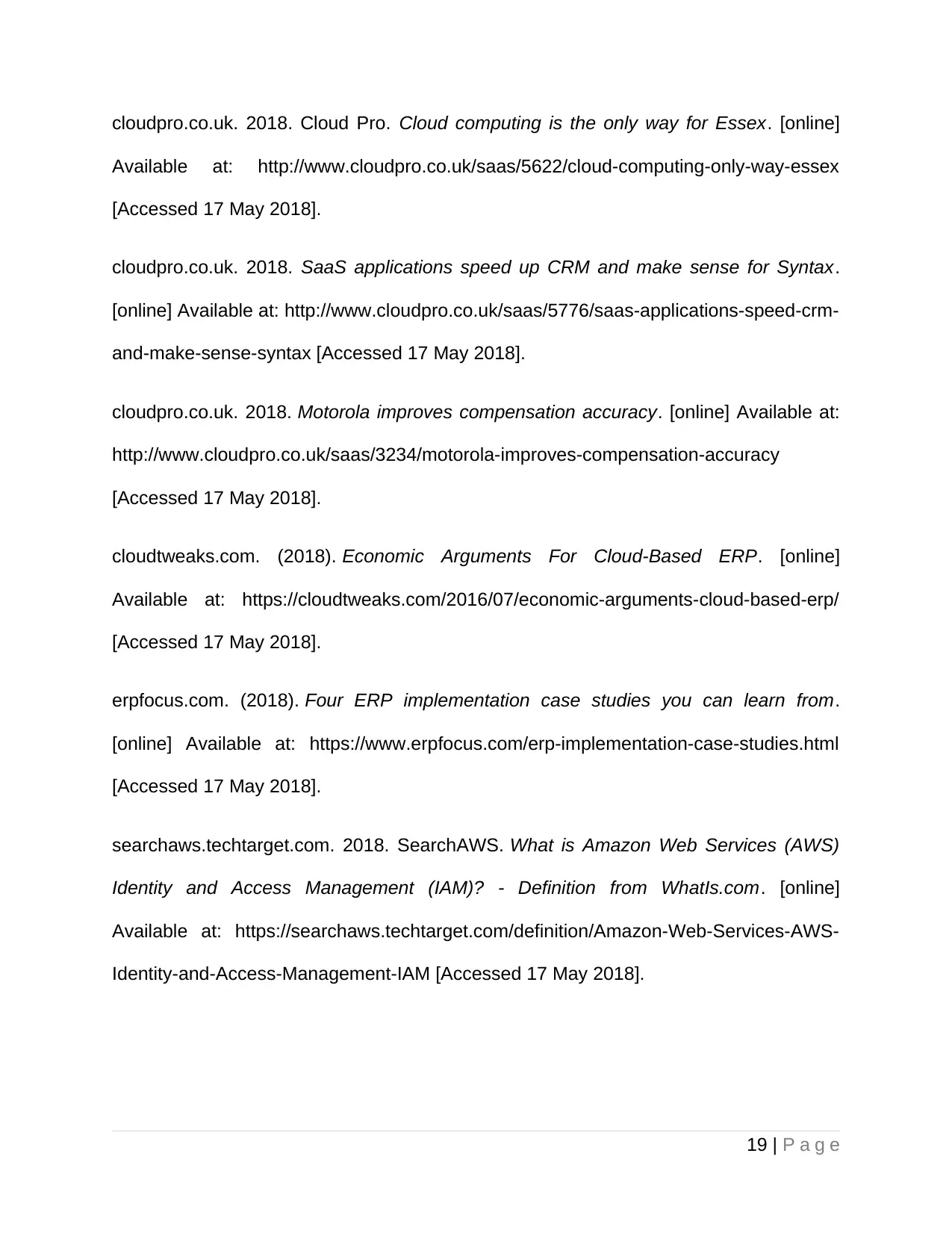
cloudpro.co.uk. 2018. Cloud Pro. Cloud computing is the only way for Essex. [online]
Available at: http://www.cloudpro.co.uk/saas/5622/cloud-computing-only-way-essex
[Accessed 17 May 2018].
cloudpro.co.uk. 2018. SaaS applications speed up CRM and make sense for Syntax.
[online] Available at: http://www.cloudpro.co.uk/saas/5776/saas-applications-speed-crm-
and-make-sense-syntax [Accessed 17 May 2018].
cloudpro.co.uk. 2018. Motorola improves compensation accuracy. [online] Available at:
http://www.cloudpro.co.uk/saas/3234/motorola-improves-compensation-accuracy
[Accessed 17 May 2018].
cloudtweaks.com. (2018). Economic Arguments For Cloud-Based ERP. [online]
Available at: https://cloudtweaks.com/2016/07/economic-arguments-cloud-based-erp/
[Accessed 17 May 2018].
erpfocus.com. (2018). Four ERP implementation case studies you can learn from.
[online] Available at: https://www.erpfocus.com/erp-implementation-case-studies.html
[Accessed 17 May 2018].
searchaws.techtarget.com. 2018. SearchAWS. What is Amazon Web Services (AWS)
Identity and Access Management (IAM)? - Definition from WhatIs.com. [online]
Available at: https://searchaws.techtarget.com/definition/Amazon-Web-Services-AWS-
Identity-and-Access-Management-IAM [Accessed 17 May 2018].
19 | P a g e
Available at: http://www.cloudpro.co.uk/saas/5622/cloud-computing-only-way-essex
[Accessed 17 May 2018].
cloudpro.co.uk. 2018. SaaS applications speed up CRM and make sense for Syntax.
[online] Available at: http://www.cloudpro.co.uk/saas/5776/saas-applications-speed-crm-
and-make-sense-syntax [Accessed 17 May 2018].
cloudpro.co.uk. 2018. Motorola improves compensation accuracy. [online] Available at:
http://www.cloudpro.co.uk/saas/3234/motorola-improves-compensation-accuracy
[Accessed 17 May 2018].
cloudtweaks.com. (2018). Economic Arguments For Cloud-Based ERP. [online]
Available at: https://cloudtweaks.com/2016/07/economic-arguments-cloud-based-erp/
[Accessed 17 May 2018].
erpfocus.com. (2018). Four ERP implementation case studies you can learn from.
[online] Available at: https://www.erpfocus.com/erp-implementation-case-studies.html
[Accessed 17 May 2018].
searchaws.techtarget.com. 2018. SearchAWS. What is Amazon Web Services (AWS)
Identity and Access Management (IAM)? - Definition from WhatIs.com. [online]
Available at: https://searchaws.techtarget.com/definition/Amazon-Web-Services-AWS-
Identity-and-Access-Management-IAM [Accessed 17 May 2018].
19 | P a g e
1 out of 19
Related Documents
Your All-in-One AI-Powered Toolkit for Academic Success.
+13062052269
info@desklib.com
Available 24*7 on WhatsApp / Email
![[object Object]](/_next/static/media/star-bottom.7253800d.svg)
Unlock your academic potential
© 2024 | Zucol Services PVT LTD | All rights reserved.




